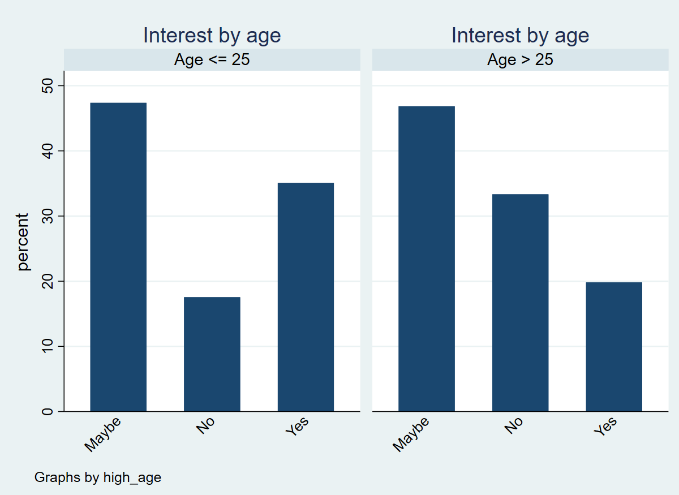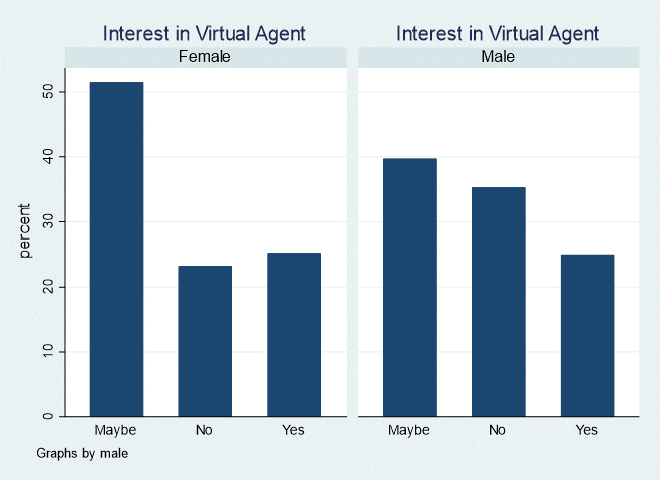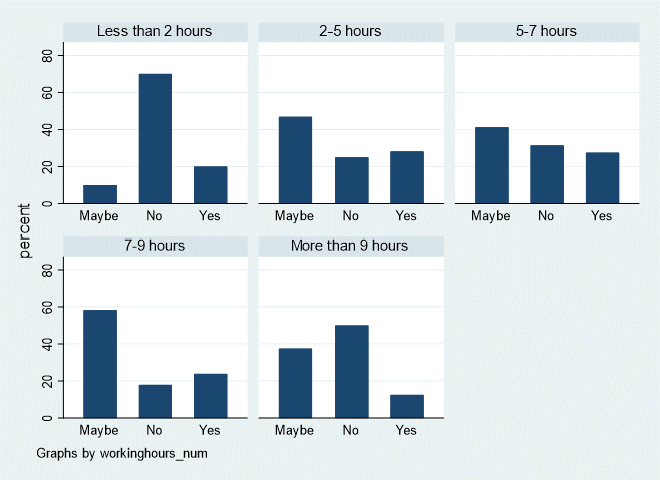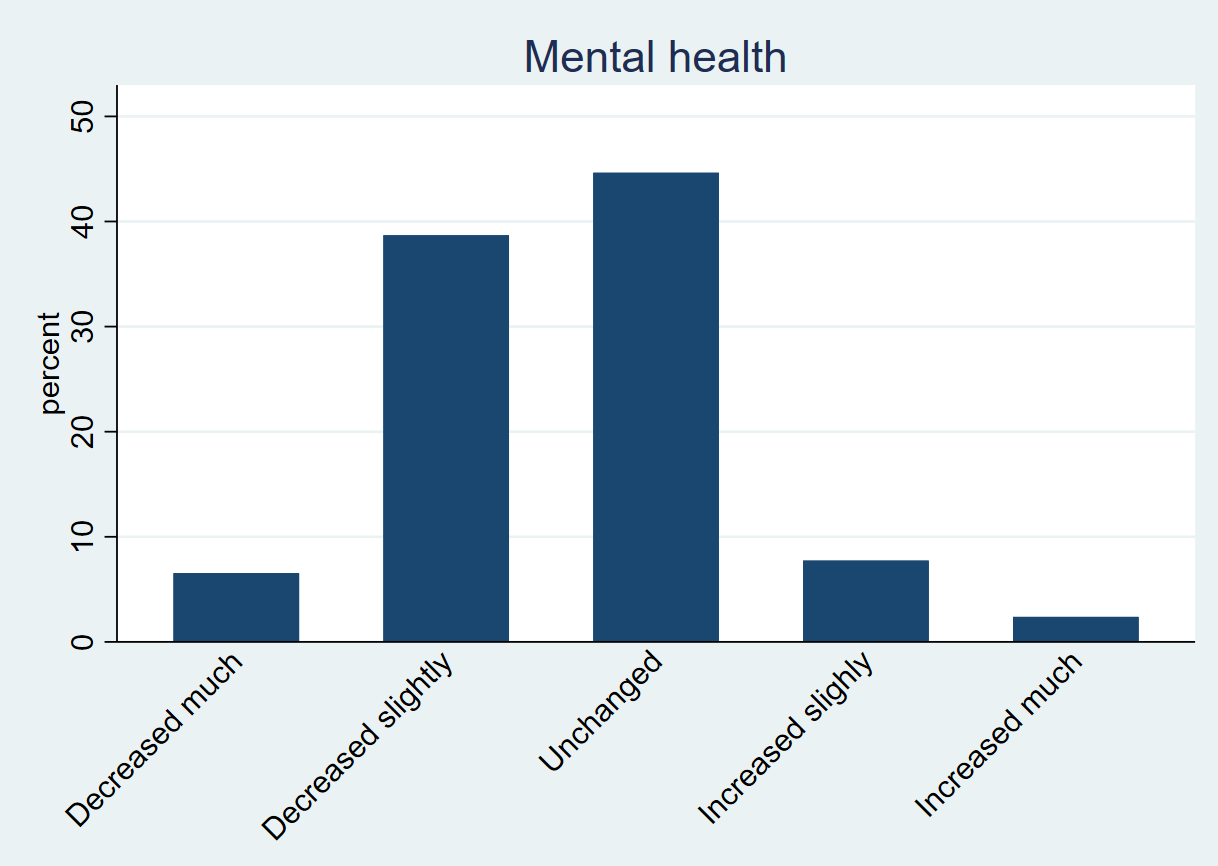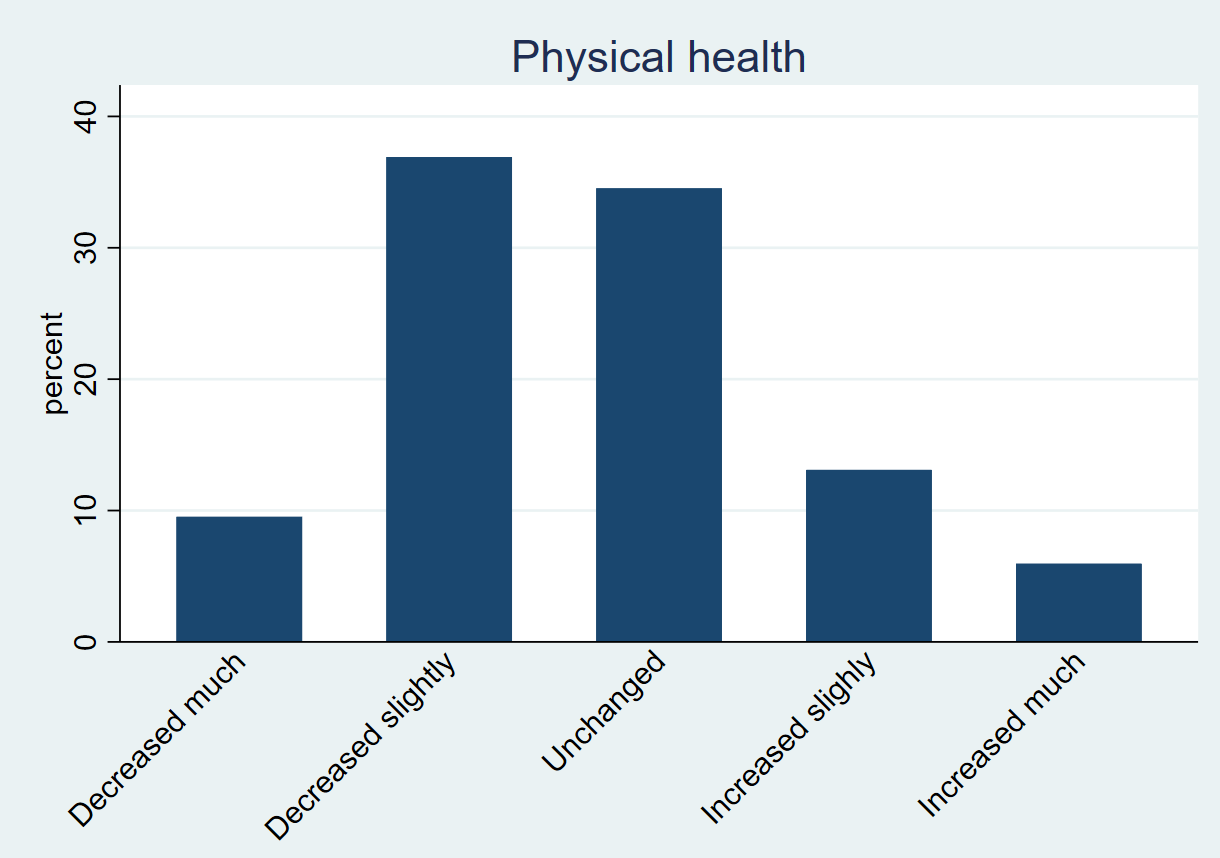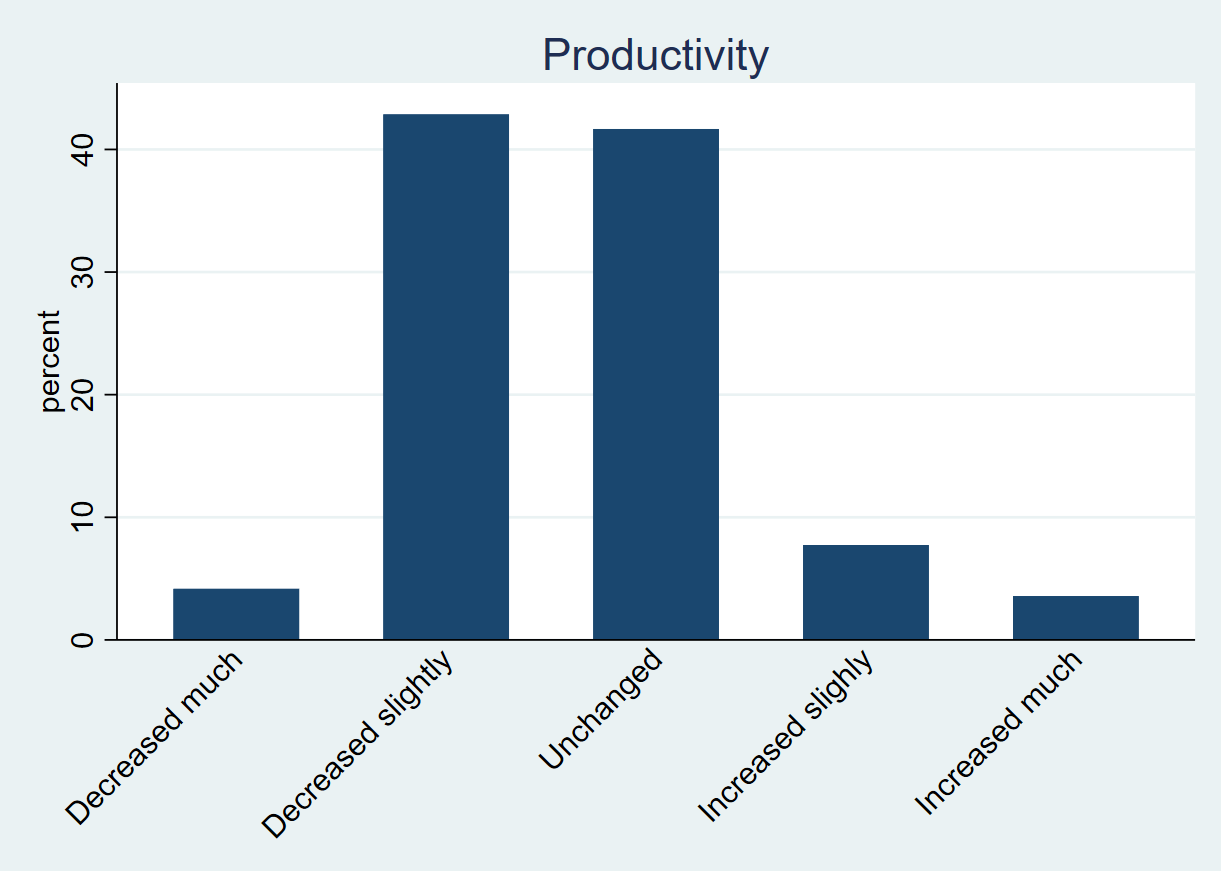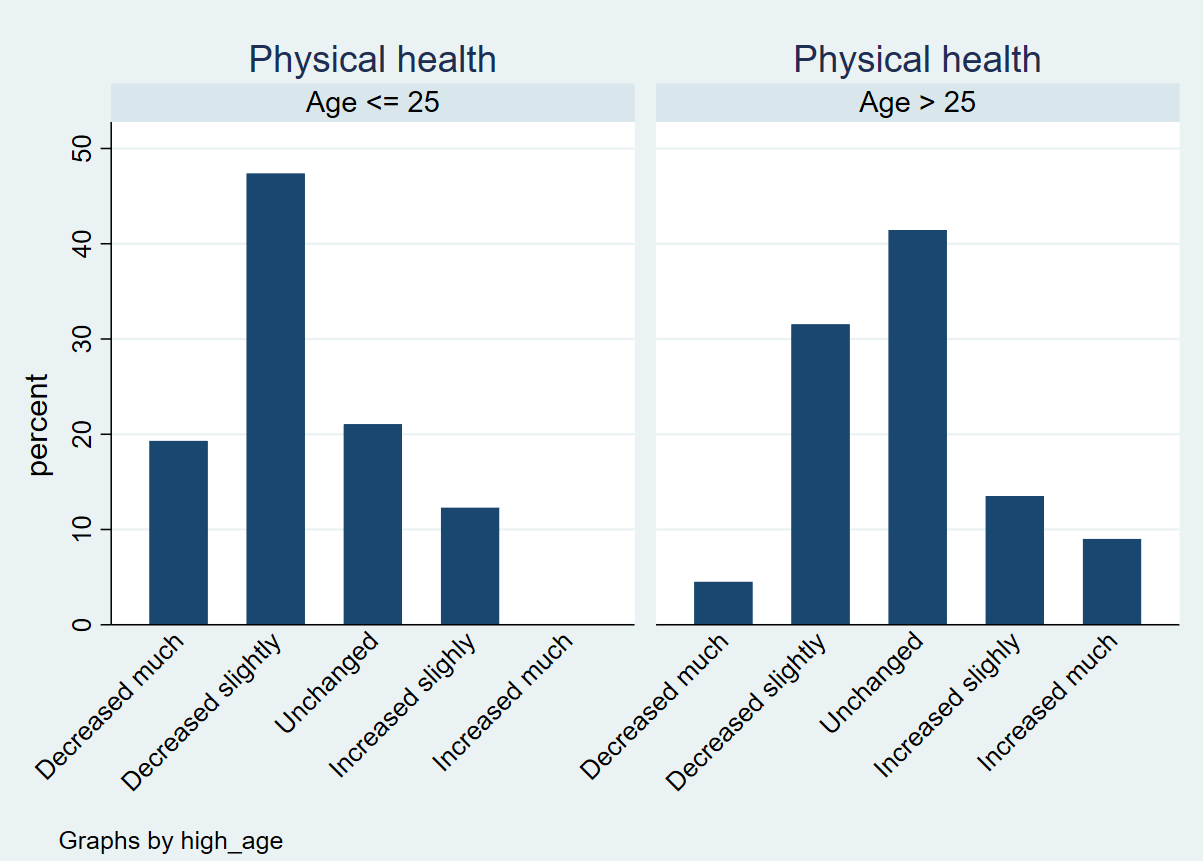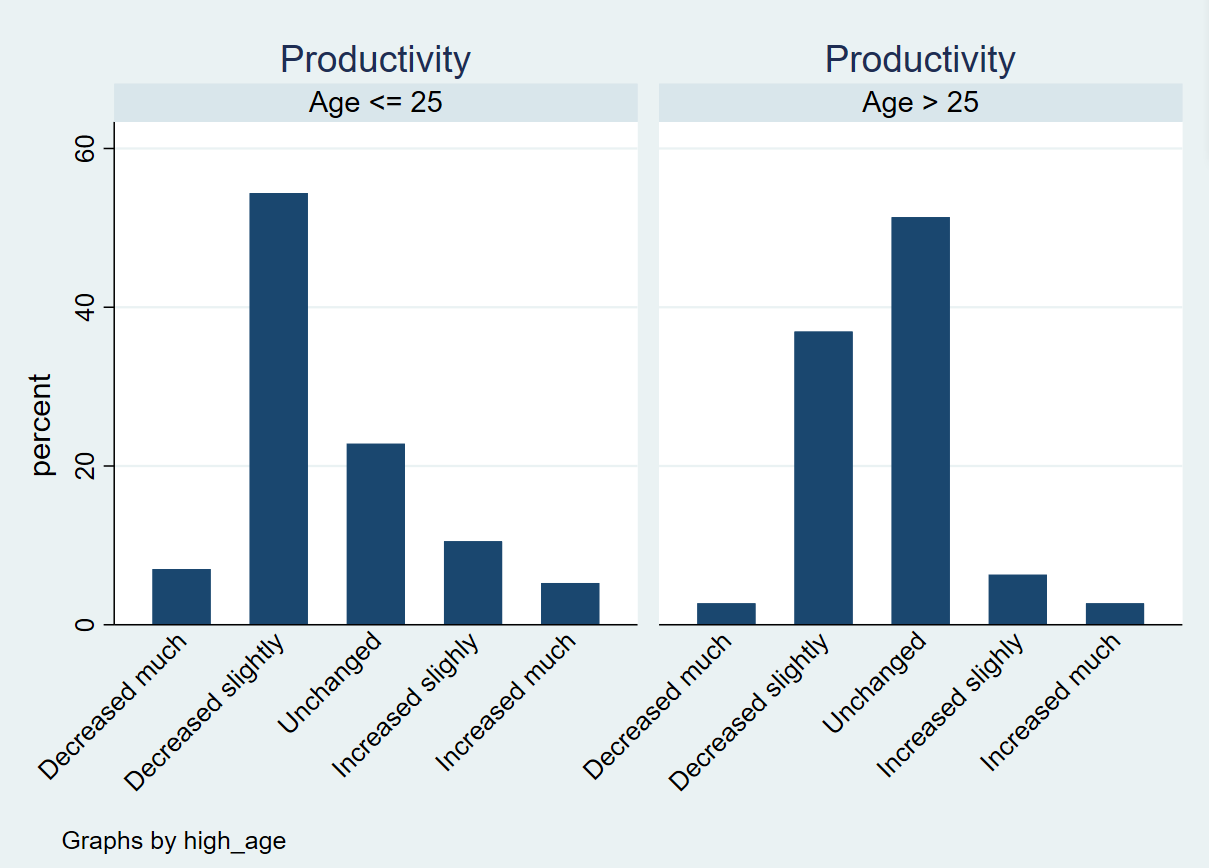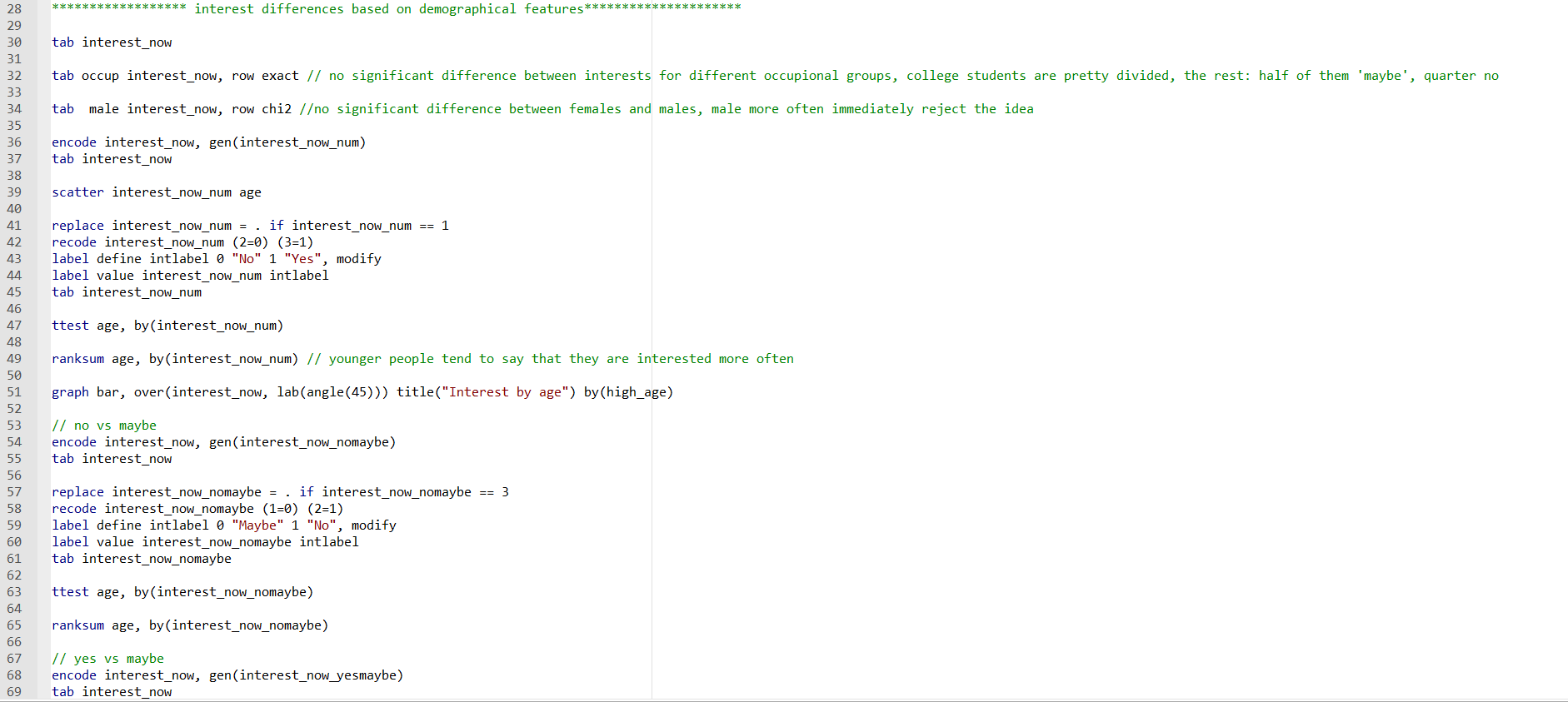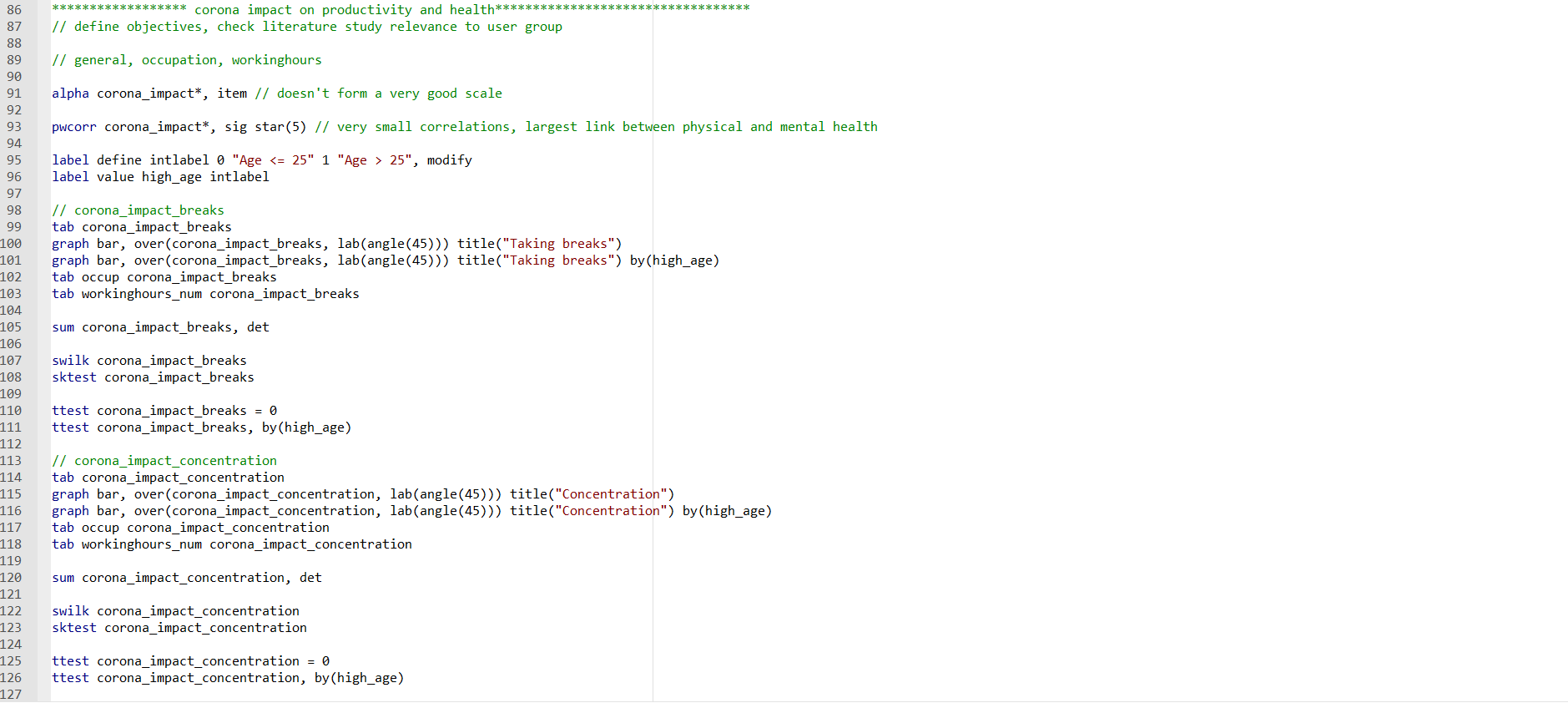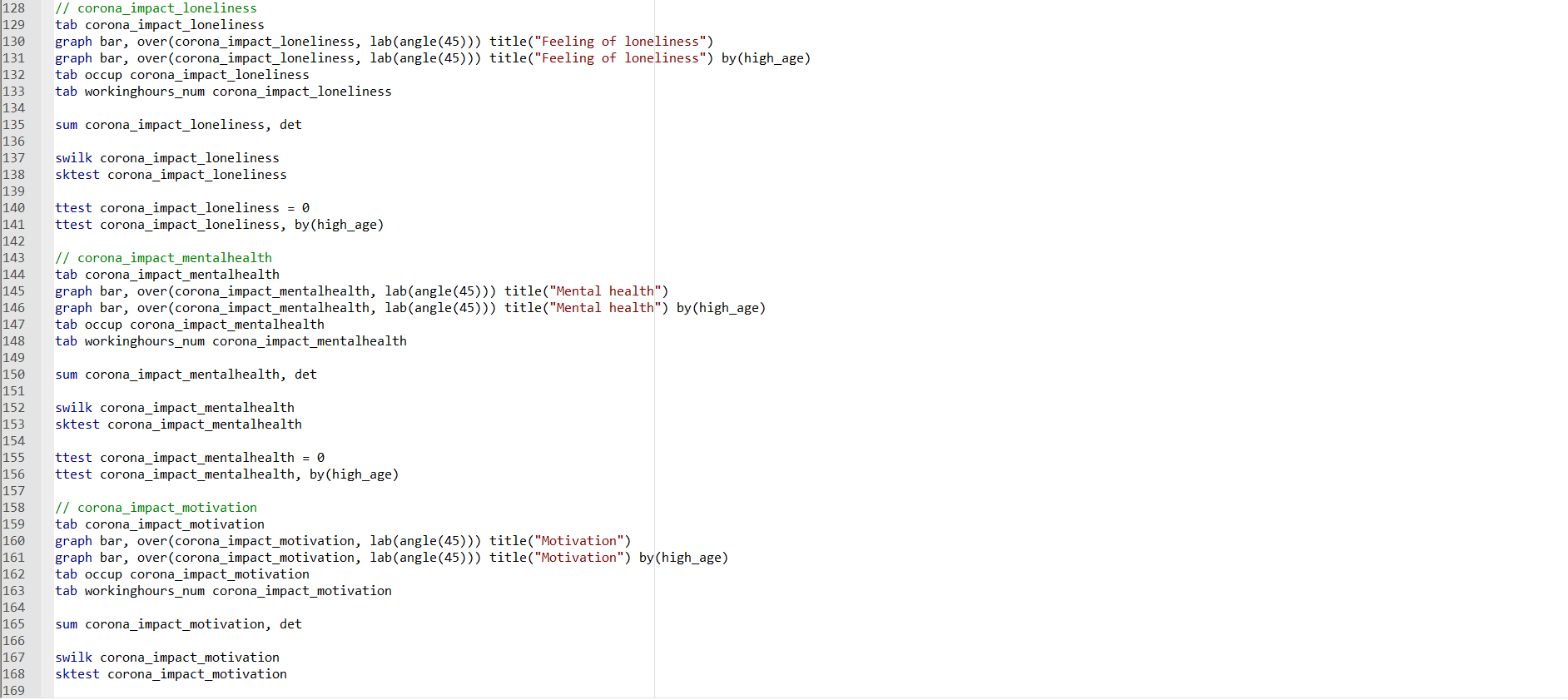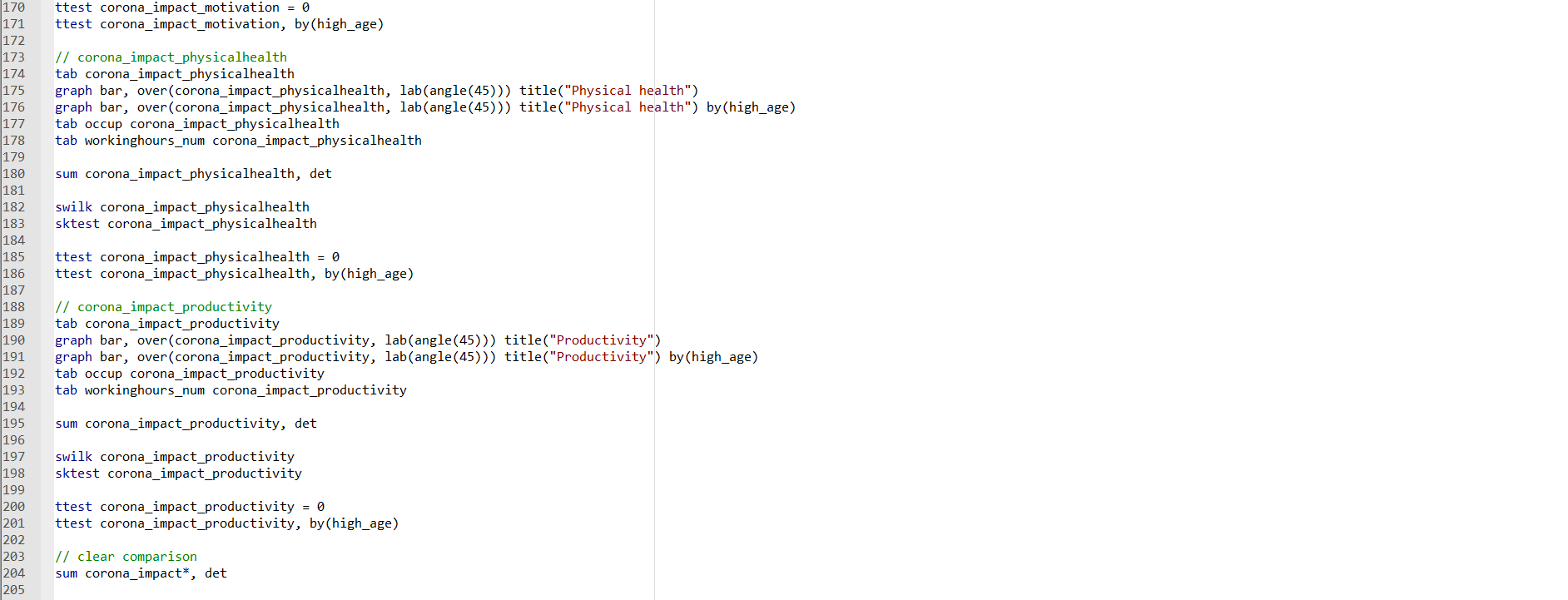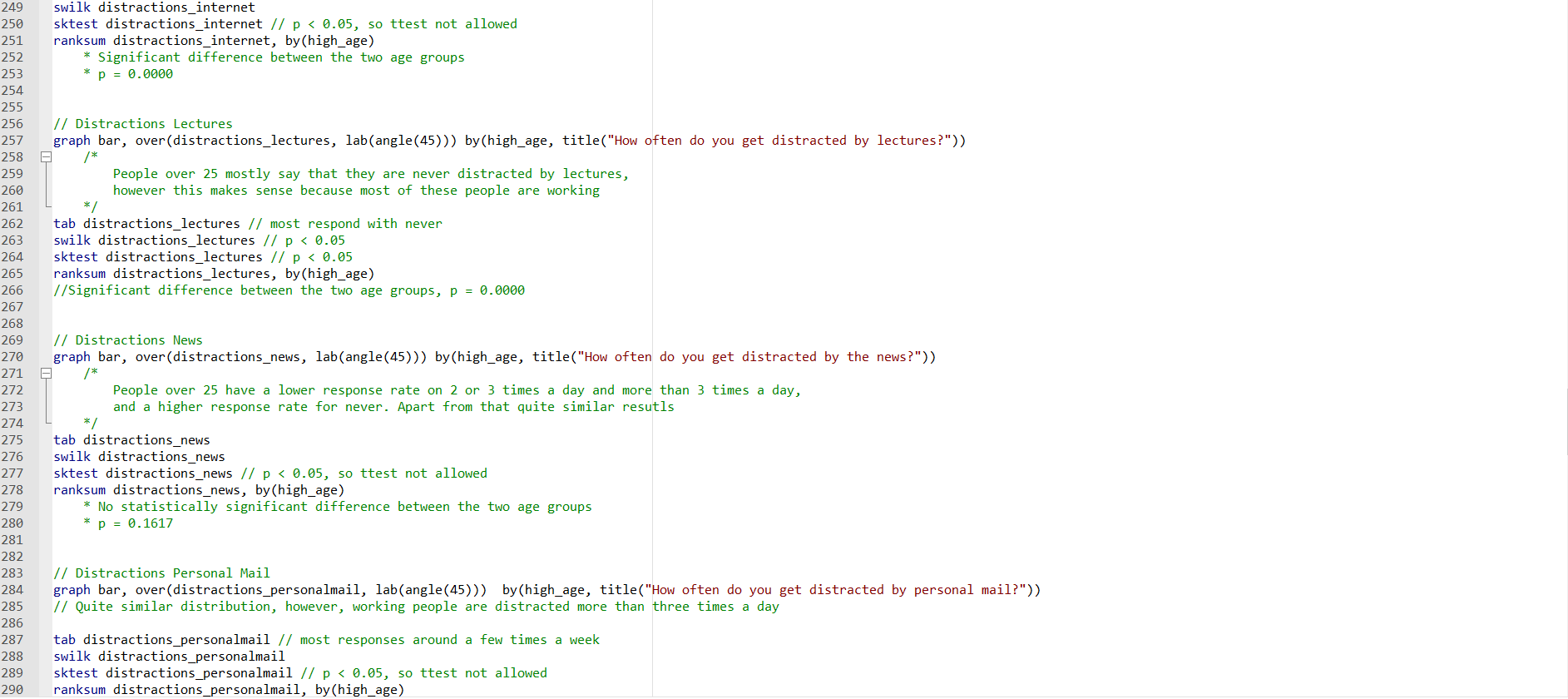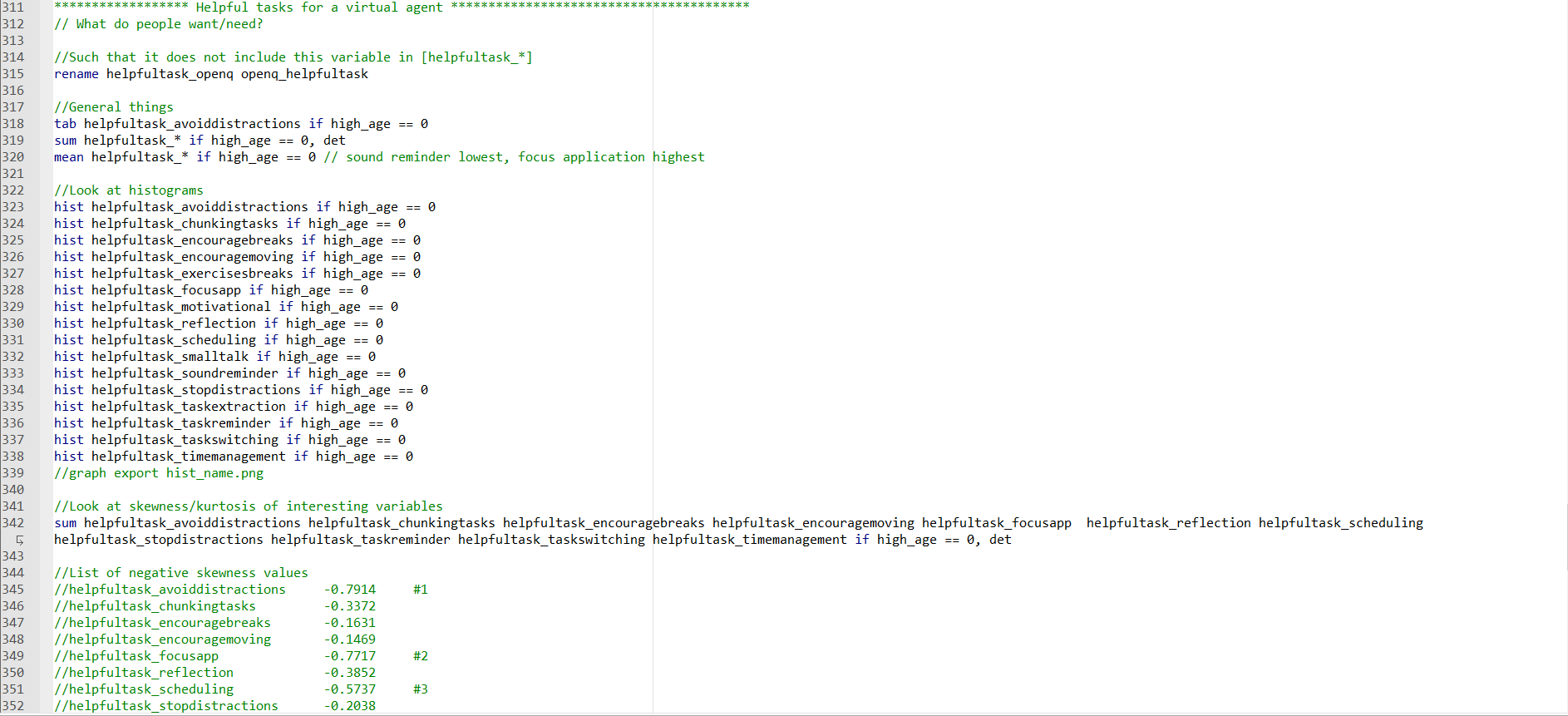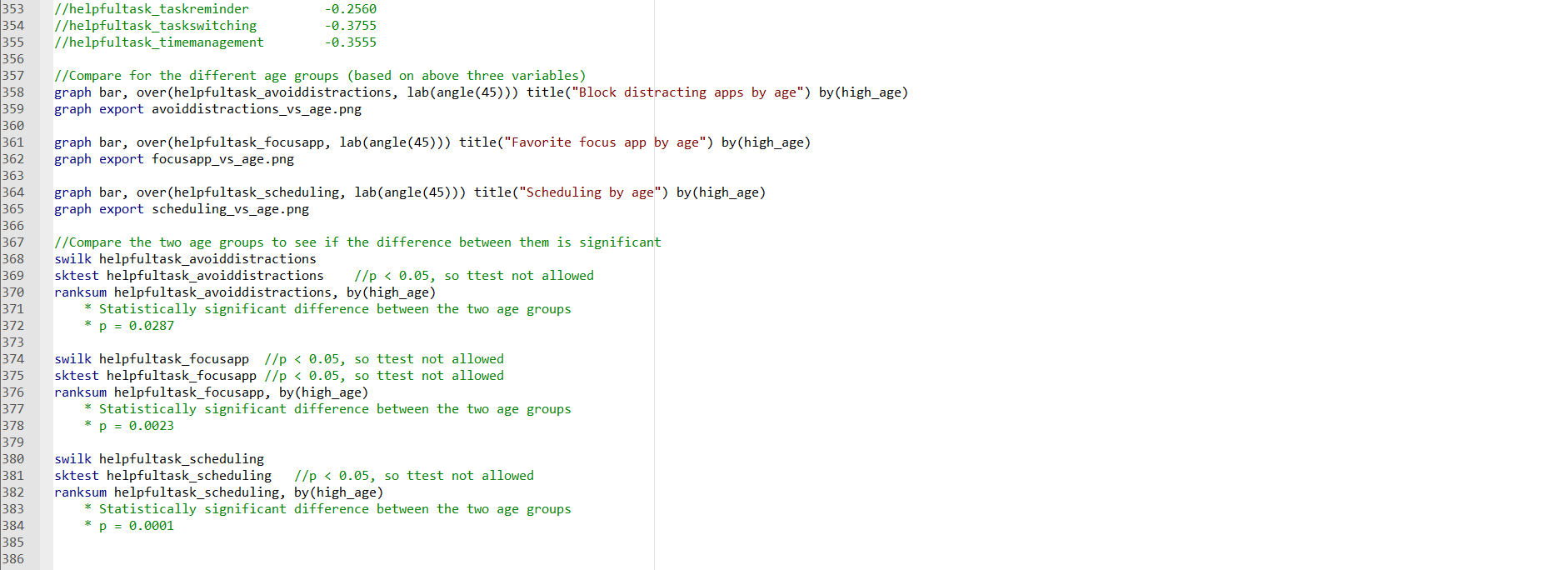PRE2020 4 Group4
Coco, The Computer Companion
Group Description
Members
| Name | Student ID | Department | Email address |
|---|---|---|---|
| Eline Ensinck | 1333941 | Industrial Engineering & Innovation Sciences | e.n.f.ensinck@student.tue.nl |
| Julie van der Hijde | 1251244 | Industrial Engineering & Innovation Sciences | j.v.d.hijde@student.tue.nl |
| Ezra Gerris | 1378910 | Industrial Engineering & Innovation Sciences | e.gerris@student.tue.nl |
| Silke Franken | 1330284 | Industrial Engineering & Innovation Sciences | s.w.franken@student.tue.nl |
| Kari Luijt | 1327119 | Industrial Engineering & Innovation Sciences | k.luijt@student.tue.nl |
Logbook
See the following page: Logbook Group 4
Subject
We want to analyze and design an AI robot componanion to improve online learning and working from home problems like diminished motivation, loneliness and physical health problems. In order to address these problems we will introduce you to Coco, the computer companion. Coco will be an artificially intelligent and interactive agent that users can easily install on their laptop or PC.
Problem Statement and Objectives
Problem Statement
Due to the COVID-19 pandemic that emerged at the beginning of 2020 everyone's lives have been turned upside down. Working from home as much as possible was (and still is) the norm in many places all around the world and it applies to office workers, but also to college-, university-, and high school students. Even though there might be benefits from working in a home office, there are also many disadvantages that are critical to everyone's health, motivation and concentration. Multiple studies have found such effects, both mental and physical, because of the work from home situation [1] [2].
Mental issues that might arise are emotional exhaustion, but also feelings of loneliness, isolation and depression. Moreover, because people have a high exposure to computer screens, they can experience fatigue, tiredness, headaches and eye-related symptoms[1]. Additionally, people exercise less while working from home during the pandemic. This can have effects on metabolic, cardiovascular, and mental health, and all this might result in higher chances of mortality[2].
Other issues are related to the concentration and motivation of the people that are working from home. Office workers that work at home while also taking care of their families have lots of problems with staying on one task, because they want to run errands for their families[1]. In addition to this, it requires greater concentration for home office workers during communication [3]. Students have also indicated to experience a heavier workload, fatigue and a loss of motivation due to COVID-19 [4].
Objectives
Our objectives are the following:
- Help with concentration and motivation (study-buddy)
- Improve physical health
- Provide social support for the user
USE: User, Society and Enterprise
Target user group
The user groups for this project will be office workers, college-, university-, and high school students, since these groups experience the most negative effects of the restrictions to work from home. There are several requirements for each group, most of them are related to COVID-19. First of all, there are some requirements relating to mental health. It is important for people to have social interactions from time to time. Individuals living alone could get mental health issues such as depression and loneliness due to the lack of these social interactions, caused by the restrictions [1]. It is also important for people to be able to concentrate well when they are working and that they can maintain their motivation and focus. Studies show that due to COVID-19 students experience a heavier workload, fatigue and a loss of motivation [4]. Considering the physical health, it is important that students and office workers are physically active and healthy. Some problems for the physical health of students and employees can arise from working from home. People that have an office job often do not get a lot of physical exercise during their workhours, but quarantine measures have reduced this even more [1]. This can affect cardiovascular and metabolic health, but even mental health [2]. In addition to this, the increased exposure to computer screens since the outbreak of COVID-19, especially applicable to high school students, can result in tiredness, headache and eye-related symptoms [1]. Hence, students and employees should become more physically active to improve their physical (and mental) health.
Secondary users
When people use Coco, they should gain better concentration and motivation and better physical health than without the computer assistant. Moreover, people that might feel lonely can find social support in Coco. Parents of the students will also profit from these aforementioned benefits of Coco, because they need to worry less about their children and their education, as Coco will assist them while studying.
Besides parents, teachers will profit from Coco too. Since Coco will help the students with studying, the teachers can focus on their actual educational tasks.
Moreover, co-workers and managers will profit from their colleagues using Coco. Coco can help the workers maintain physical and mental health which in turn leads to a better work mentality and environment
Society
When people use Coco the computer companion they will have better, concentration, motivation and better mental and physical health. This means that a lot of people in the society will have a higher well-being which in turn results in a healtier society. Moreover, because people work and study better both companies and the schools will have better results.
Enterprise
There are two main stakeholders for enterprises. Coco needs to be developed and this is where a software company comes in. Such a company will develop the virtual agent and will sell licenses to other companies. These companies are the other stakeholders and are interested in buying Coco for their employees or students. This could be small enterprises that want to buy a license for a small group of employees, but also large universities that want to provide the virtual agent for all their students. The effects for the software development company will be economic, since they will earn money with selling the Coco software licenses. For the interested companies, buying the license will mean that their employees’ physical and mental health will increase i.e., the primary users’ benefits.
Approach
In order to address the consequences and improve health and motivation in home-office workers, we will introduce to you Coco, the computer companion. Coco will be an artificially intelligent and interactive agent that users can easily install on their laptop or PC.
Concerning the mental health of users, a main problem is loneliness. It has been researched before what the impact of robotic technologies is on social support. Ta et al [5] have found that artificial agents do not only provide social support in laboratory experiments but also in daily life situations. Furthermore, Odekerken-Schröder et al. (2020) have found that companion robots can reduce feelings of loneliness by building supportive relationships[6].
Regarding the physical well-being of users, the use of technology could be useful to improve physical activity. As stated by Cambo et al. (2017), using a mobile application or wearable that tracks self-interruption and initiates a playful break, could induce physical activity in the daily routine of users [7]. Moreover, Henning et al. (1997) have found that at smaller work sites, users’ well-being improved when exercises were included in the small breaks [8].
Finally considering the productivity of users, a paper by Abbasi and Kazi (2014) shows that a learning chatbot systems can enhance the performance of students[9]. In an experiment where one group used Google and another group used a chatbot to solve problems, the chatbot had impact on memory retention and learning outcomes of the students. The same research as mentioned before from Henning et al also showed that not only the users’ well-being, but also the users’ productivity would increase in the presence of a chatbot[10]. Moreover, as has been researched in an experiment of Lester et al. (1997), the presence of a lifelike character in an online learning environment can have a strong influence on the perceived learning experience of students around the age of 12. Adding such an interactive agent to the learning process can make it more fun, next to the fact that the agent is perceived to be helpful and credible[11].
Method
At the end of the project, we will present our complete concept of the AI companion. This will include its design and functionality, which are based on both literature research and statistical analysis of send-out questionnaires. The questionnaires will be completed by the user group to make sure the actual users of the technology have their input in the development and analysis of the companion. Moreover, the user needs and perceptions will be described. The larger societal and entrepreneurial effects will also be taken into account. In this way, all USE-aspects will be addressed. Finally, a risk assessment will be included, as limitations related to the costs and privacy of the product are also important for the realization of the technology. These deliverables will be presented both in a Wiki-page and final presentation. A schematic overview of the deliverables can be found in Table 1.
Table 1: Schematic overview of the deliverables
| Topic | Deliverable |
|---|---|
| Functionality | Literature study |
| Results questionnaire 1: user needs | |
| Design | Results questionnaire 2: design |
| Example companion | |
| Additional | Risk assessment |
Milestones
During the project, several milestones are planned to be reached. These milestones correspond to the deliverables mentioned in the section above and can be found in table 2.
Table 2: Overview of the milestones
| Topic | Milestone |
|---|---|
| Organization | Complete planning |
| Functionality | Complete literature study |
| Responses questionnaire 1: user needs | |
| Complete analysis questionnaire 1: user needs | |
| Design | Responses questionnaire 2: design |
| Complete analysis questionnaire 2: design | |
| Design of the companion |
Survey
To find out more about the group of people that will be most interested in having a virtual companion, a survey will be conducted. This survey is meant to specify the target group and to get to know their preferences regarding the functionality of the virtual agent. The survey consists of 21 questions about Coco divided into the topics demographics, general computer work, productivity, tasks of a VA, privacy and interest. The link to the survey can be found here. And the analysis of the survey can be found here.
Planning
Research
State of the Art
Productivity agents
As discussed by Grover et al. [12] multiple applications exist that focus on task and time management. They all try to assist their users but do so in different ways. “MeTime”, for example, tries to make its users aware of their distractions by showing which apps they use (and for how long). “Calendar.help”, on the other hand, is connected to its user's email and can schedule meetings accordingly. Other examples include “RADAR” that tackles the problem of “email overload” and “TaskBot” that focuses on teamwork.
Grover et al. mention how Kimani et al. [13] designed a so-called productivity agent, in an attempt to incorporate all the beforementioned applications with different functions into one artificially intelligent system. The conversational agent that they described focused on improving productivity and well-being in the workspace. By means of a survey and a field study, they investigated the optimal functionality of a productivity agent. Findings suggests four tasks that are most important for such agents to possess. These tasks include distraction monitoring, task scheduling, task management and goal reflection. [12]
With their research, Grover and colleagues [12] wanted to get more insight on the influence of anthropomorphic appearance in agents versus a simple text-based bot which lower perceived emotional intelligence. Even though productivity was increased with the presence of a chatbot, outcomes suggest that there was no significant performance difference between the virtual agent and the text-based agent. Interaction with the virtual agent was however perceived to be more pleasant, supporting the idea that higher emotional intelligence in agents can reduce negative emotions like frustration [14]. The researchers also found that it is important that the appearance of the agent matches their capabilities, meaning that agents should only have anthropomorphistic looks if it can also act human-like. Other suggestions for improvement were focused on the agent’s inflexible task management skills and inappropriately timed distraction monitoring messages. Those last points especially will act as a guidance in designing an improved Agent System Architecture during this research. Grover et al. suggest including an additional dialog model into the agent architecture, which could be initiated by the user when they want to reschedule or change the duration of a task. They also suggest extending the distraction detection functionality and let users personalize their list of distracting websites and applications.
Companion agents
When going to the Play Store or App Store on your mobile phone, you can download “Replika: My AI Friend". This is a companion chatbot, that imitates human-like conversations. The more you use the app, the more it also learns about you. Ta et al. [5] investigated the effects of this advanced chatbot. They found out that it is successful in reducing loneliness as it resembles some form of companionship. Some other benefits were found as well. These include its ability to positively affect its users by sending positive and caring messages, to give advice, and to enable a conversation without fear of judgements.
Physical health agents
Cambo, Avrahami, & Lee [15] investigated the application “BreakSense” and concluded that the technology should let the user decide for themselves when to take a break. They discovered that in this way, the physical activity became part of their daily routine.
Computer assistants
Although these agents focus on specific tasks, there also exist personal computer assistants that are developed to help, for instance children, more generally with their daily activities. The study by Kessens et al. [16] investigated such a computer assistant, namely the Philips iCat. This animated virtual robot can show varying emotional expressions and fulfilled the roles of both companion, educator and motivator.
Related Literature
General
A list of related scientific papers, including short summaries stating their relevance, can be found here.
Design of the Virtual Agent
In week 3 a separate literature study has been conducted, specifically focused on the design aspect of the virtual agent. As a result of this study, it is planned to form a scientifically grounded recommendation for the design of the virtual agent, based on the direction of all papers taken together.
An overview of the collected data regarding the design and appearance of the agent can be found here.
Motivation for virtual agent
This section contains the motivation for the decision to develop a virtual agent instead of a physical robot. Several important aspects of Coco will be discussed to reach this, including its emotional intelligence, embodiment and costs. Disclaimer: this is still a concept and will thus be extended later
Emotional intelligence and communication
One of the qualities of Coco should be that it is able to provide social support (objective 3). Of course, the question arises whether artificial agents can actually ‘understand’ feelings, or whether they are simply manipulating symbols. A famous thought experiment, called the Chinese Room, covers this topic [17]. Regardless of this, we would like Coco to show emotional intelligent behavior (whether it then actually has intelligence or not is a topic that is left for discussion).
Research has shown that artificial agents that show such intelligent behavior come across as more reliable than robots that lack this property (Fan, Scheutz, Lohani, Mccoy, & Stokes)[18]. Moreover, robots that do not show intelligent behavior can be experienced as confusing or unpredictable to humans. As soon as behavior is misinterpreted by the users, emotional harm could be caused (Fan et al.)[18]. And emotional harm should of course be prevented from happening.
Another advantage of a virtual agent is the fact that it can process both spoken and written language. This option allows easier communication between Coco and its users, as no confusions can arise due to accents or bad pronunciations. Even though a physical robot can also process spoken language, it cannot process written language if not connected to a laptop or computer. Additionally, language processing software on a laptop can be easily updated.
A virtual agent with intelligent behavior would hence be preferred over a robot without intelligent behavior.
Physical versus simulated embodiment
Tanaka, Nakanishi & Ishiguro have found in an experiment that the physical embodiment of a robot enhanced the social telepresence, which is the feeling of face-to-face interaction while a person is not physically present (e.g. using video calls). However, they have also found that this social telepresence decreases the smoothness of speech of the participant(Tanaka, Nakanishi, & Ishiguro) [19].
According to Milne et al., the most important advantages of virtual agents are that they can be accessed at any time and that they do not need to be repaired (Milne, Luerssen, Lewis, Leibbrandt, & Powers) [20].
The article of Lee, Jung, Kim & Kim investigates one of the most fundamental questions about social robots, namely whether physical embodiment adds value for good social interaction compared to social robots without embodiment. For instance, manufacturing of embodied robots is very expensive, and many technical difficulties can arise because of the many embedded sensors and motors. However, they did find that physically embodied agents may facilitate better social interaction because the physical robot can provide more affordance for social interaction. (affordance means that the properties of the robot show how it should be used).
Lee et al. also found that if an embodied robot had an “anthropomorphic-physical embodiment”, which means that human characteristics are assigned to it, expectations of the robot were very high. When it then did not have the ability to react to touch-input, the high expectations of the people dropped and they became frustrated and disappointed in the robot. This might be a general negative effect of physical embodiment (especially for lonely people that might want to use the robot as a real companion). [21].
Wang & Rau have researched the effect on users’ responses of different types of social robots. They distinguished on two factors; embodiment and substrates. It has been found that people prefer that the embodiment matches the substrate. This means that they would prefer if a physical robot has the best effect in a physical substrate, but a virtual robot the best in a virtual substrate. This means that our design idea matches their research findings and that a virtual context (i.e. a computer/laptop) will best comply with a virtual embodiment [22]. A different paper agrees with Wang & Rau and also recommends that a virtual agent works best in a 2D environment, while a physical robot works best in a 3D environment [23].
Costs
A paper on design of social robots from Puehn et al. compares a low-cost social robot ‘Philos’ to commercial social robots. Their design idea Philos has a commercial value of $3,000 and the associated software is free. But the more widely known, higher quality robots, like the animal robot Paro and humanoid robot Nao, cost way more than that, namely $6,000 and $15,000 respectively[24].
Also, Avramova et al. mentions that physical robots are expensive in their development and maintenance, whereas software can easily be updated. [25].
- https://www.webfx.com/internet-marketing/ai-pricing.html is an interesting website to see how much it will cost to develop AI software. Comparing e.g. chatbots, large data analysis systems and virtual assistants.
Functionalities
In order to improve its user's concentration and motivation (objective 1), Coco would benefit from permission to control apps or websites. Imagine, for instance, that someone has his/her social media open when trying to make exercises. Incoming messages could cause a lot of distraction, which could be prevented by (temporarily) blocking this website. Related to this, Coco could monitor your activity on the computer. In this way, it could provide summaries and recommendations on how you should invest your time.
Coco could also be used to make an efficient and motivating planning for its users. Being able to link Coco to the user's schedule would be necessary for this task.
Hence, some of the desired functionalities of Coco are thought to be implemented easier in a virtual agent than in a physical robot.
Conclusion
Although physical robots could be a better choice for certain applications, it seems that in the end for Coco, the costs and benefits of a virtual agent outweigh the benefits of a physical robot. One large advance is the fact that a virtual agent would make the technology better accessible to a large public. Although not everyone has the money to buy an advanced robot, many would be able to invest in a license to use the software. In this way, the objectives of Coco, can be achieved the best by developing a virtual agent.
Analysis Survey 1
Interest
When it comes to interest in the VA, almost half of the respondents expressed their doubts. They did not immediately reject the idea, but thought their choice depended on for example the situation and the functionality of the agent. When looking at age, people that were not sure were distributed very evenly. A Wilcoxon rank-sum test however shows a significant difference in age for people who say they would be interested and people who say they are not (p=0.001). It seems younger people are more open to the idea of having a virtual agent.
Looking at gender, both males and females are interested for around 25% of the time. Even though the figure below suggests that females more often consider the idea of having a virtual agent, this difference is not significant (X^2, p=0.07).
From Figure 4 we can also conclude that people who use their laptop around 7-9 hours a day are most open to the idea of a virtual agent. Least interested are people who use their computer less than 2 hours a day, or more than 9 hours. For both groups respondents indicated that they do not need such a virtual agent.
Corona impact on productivity and health
The second part of the analysis was about the influence of corona on productivity and health. Several research questions have been formulated:
Do people feel that their productivity, including concentration and motivation , has decreased because of the corona virus?
Do people feel that their physical health has decreased because of the corona virus?
Do people feel that their mental health has decreased because of the corona virus?
Considering the effect of COVID-19 on people's perception of their work situation, several observations can be made. Generally, mental health, loneliness and productivity are the three areas that have been negatively impacted by the corona crisis the most.
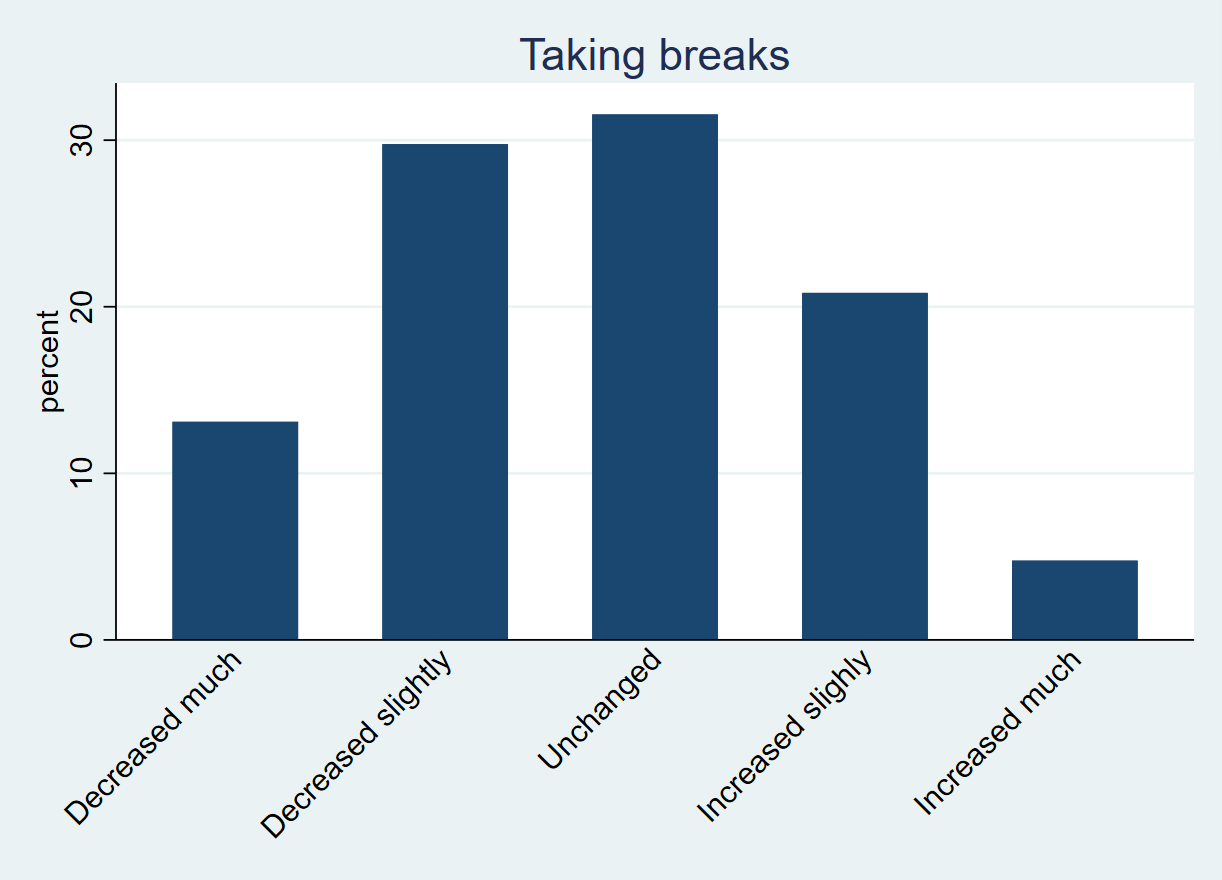
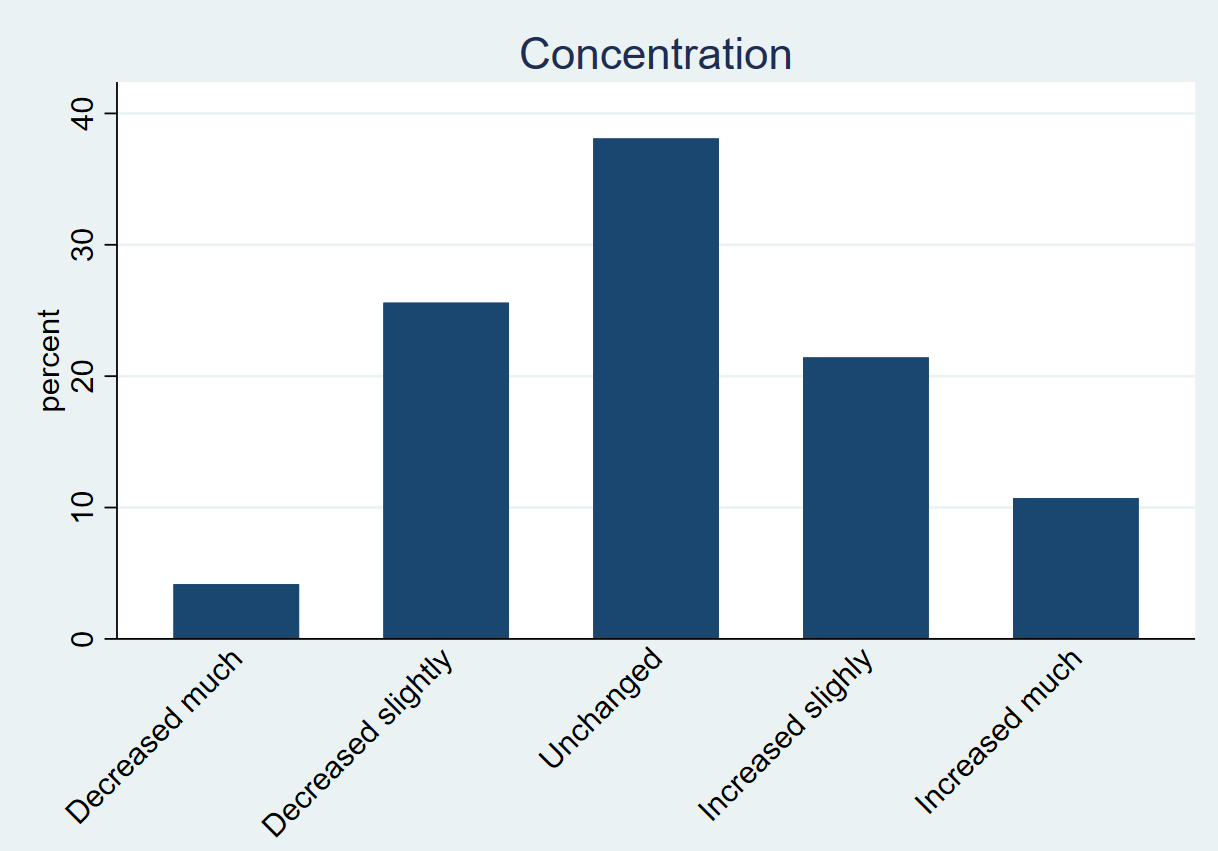
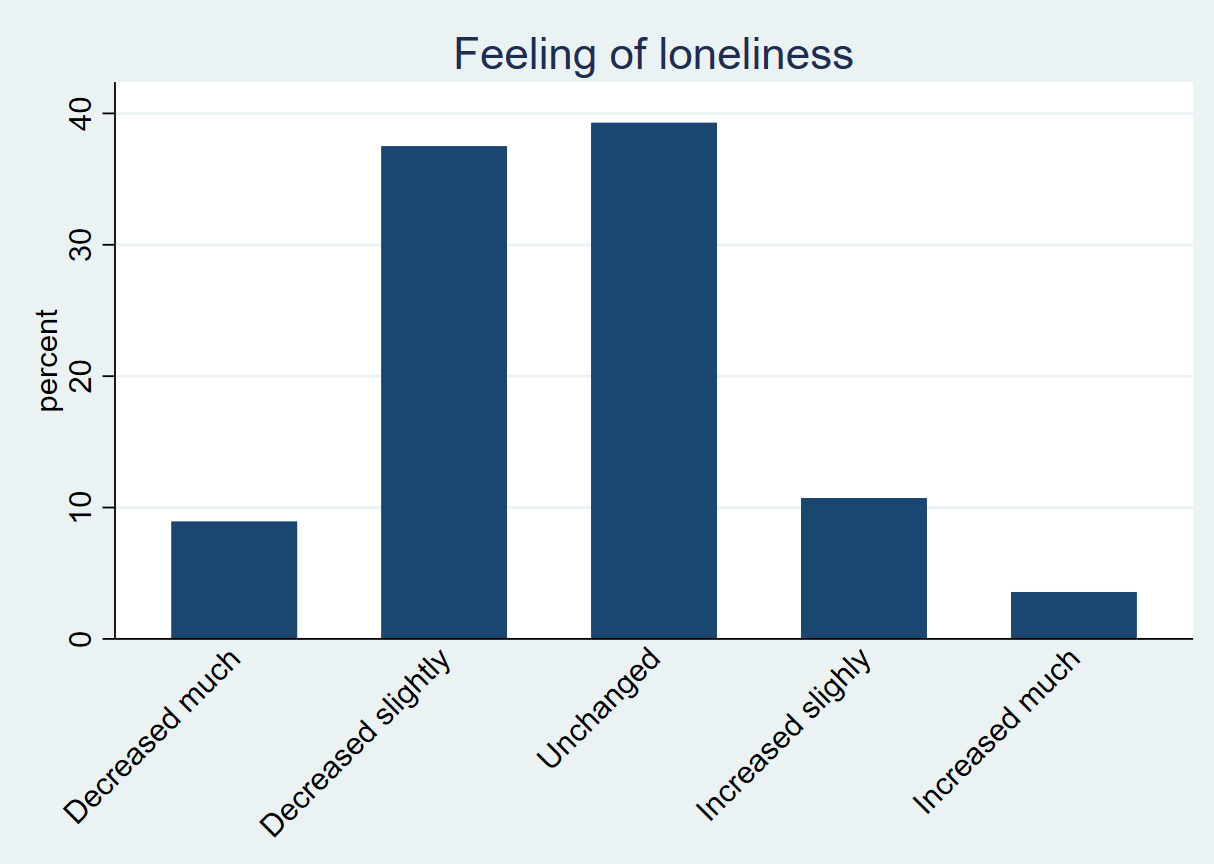
Since this questionnaire was also made to determine the user group that would need the help of a VA the most, the following matters will also be analyzed based on age. Generally, people older than 25 take less breaks since COVID-19, and younger people tend to take more breaks. Younger people generally think their concentration has decreased since COVID-19 and on the other hand, people older than 25 generally say their concentration has increased. However, both groups state their productivity has decreased. Although both groups state that their mental health, physical health and feeling of loneliness have decreased since COVID-19, the younger user group indicates a greater negative impact.

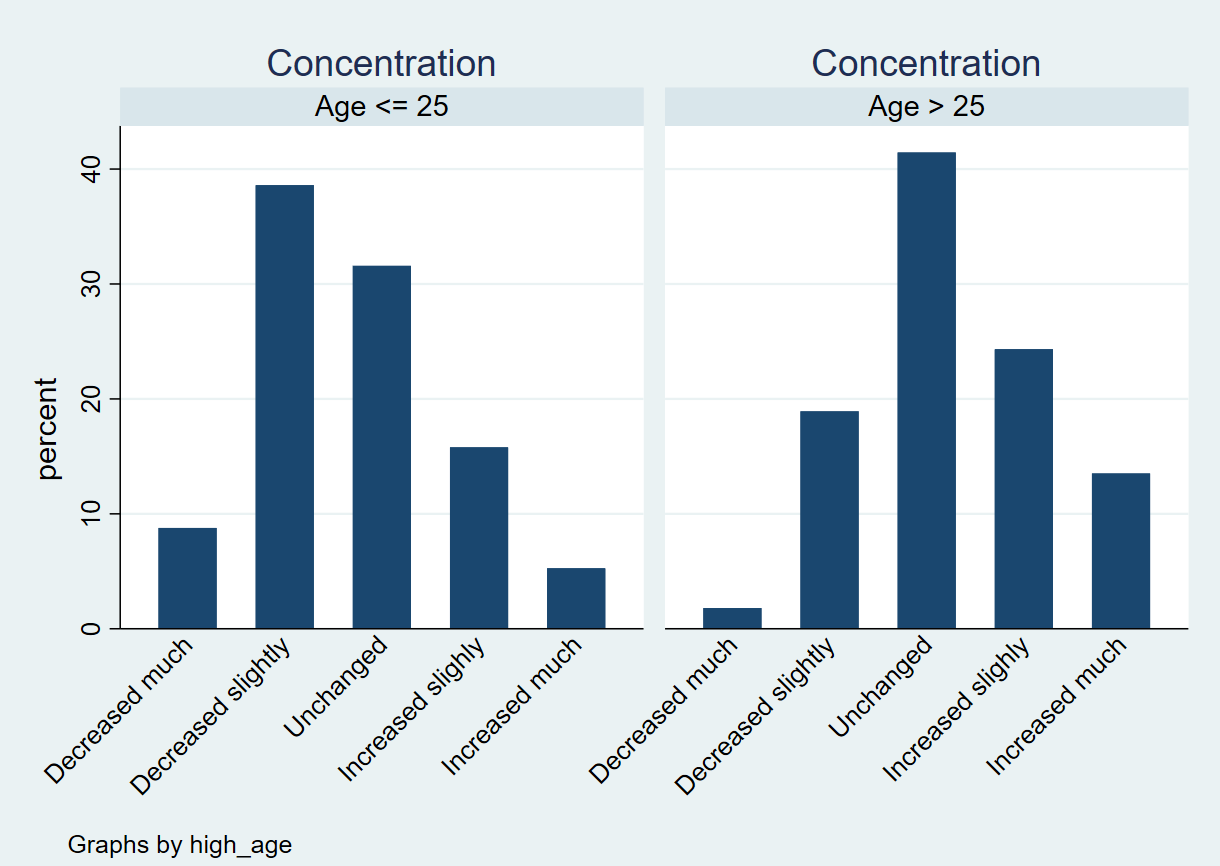
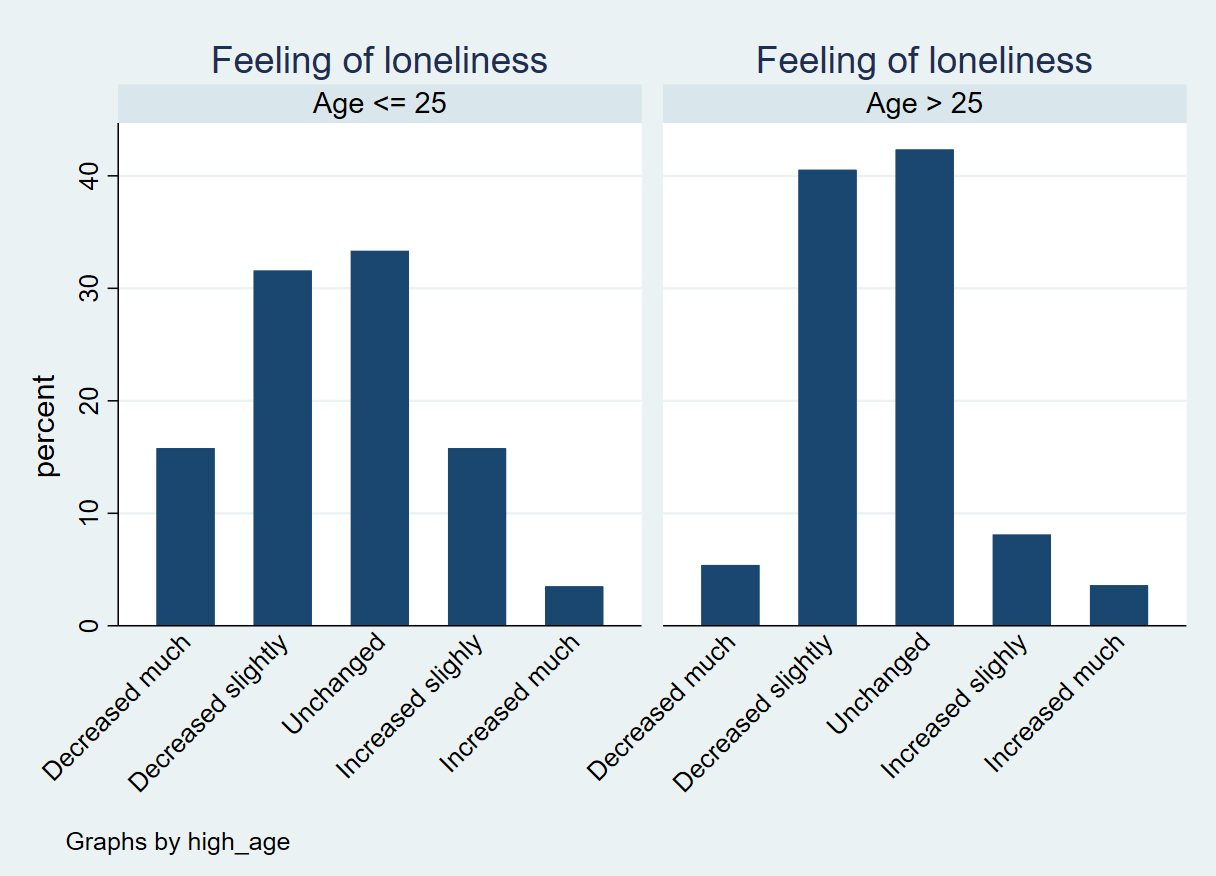
In Table 1 the means of the two groups are shown to clarify the above made statements. When the mean is smaller than 0, there is on average a decrease and if this impact is bigger than 0, there is on average an increase. There is a significant difference between the two groups if the p-value is smaller than 0.05. All this information suggests that it might be best to focus on people of 25 or younger for this research and the development of the computer companion.
Table 1: The means for several corona impact measurements and the differences between the different age groups.
| Aspects | Mean <= 25 | Mean > 25 | p-value |
|---|---|---|---|
| Taking breaks | 0.19 | -0.49 | 0.0001 |
| Concentration | -0.30 | 2.9 | 0.0004 |
| Feeling of loneliness | -0.40 | -0.36 | 0.7745 |
| Mental health | -0.61 | -0.28 | 0.0117 |
| Motivation | 0.37 | 0.19 | 0.1868 |
| Physical health | -0.74 | -0.09 | 0.0001 |
| Productivity | -0.47 | -0.31 | 0.2165 |
To summarize, considering all respondents the productivity, physical health and mental health have decreased. Generally, concentration has not been affected by COVID-19. Respondents even indicated an increase in motivation. Once the respondents were grouped by age, a clear difference in responses could be seen. The people of 25 years old and younger indicated a slight decrease in concentration, while people over 25 indicated a slight increase in concentration. Even though both groups indicated a decrease for most other cases, people of 25 years old and younger indicated a higher decrease in mental health, physical health and productivity. For both groups motivation increased, but there was a bigger increase indicated for the younger group.
Regarding the open question 'Are there other activities than the ones mentioned above that you often experience to negatively impact your productivity?', around 20 people mentioned that phone calls, applications like Netflix, and message platforms like Microsoft Teams and WhatsApp disturb their productivity. Besides that, 15 participants mentioned that their family and other people in their household negatively impact productivity. Children for example ask for a lot of attention when parents are working at home, and they need to be helped with homeschooling (unfortunately, Coco will not be able to solve this problem). Besides these two main impact factors, some participants also mentioned no breaks, lack of physical contact, the mailman, spontaneous household chores, unstructured schedules, bad sleep quality, a non-stimulating workplace, ambient noise, and the monotony of the day as things that negatively impact productivity.
Helpful tasks for a virtual agent
The third part of the analysis was about the tasks of a virtual agent users would see as useful. The research question for this part is: Which tasks are most important for a computer companion to possess?
Sixteen different variables are used to see what users prefer as tasks for a virtual agent. For every variable, the respondents could choose five options from a Likert scale varying between ‘Not useful at all’ to ‘Very useful’. From the histograms it can be seen that ‘Help avoiding distractions by blocking applications’, ‘Help to split up daunting tasks’, ‘Encourage taking breaks’, ‘Encourage physical activity during breaks’, ‘Help increase productivity with your favorite concentration/focus application’, ‘Reflect on work at the end of the day’, ‘Help schedule tasks in your preferred scheduling application’, ‘Help you to focus on a currently scheduled task by getting you back from distractions’, ‘Providing reminders of your schedule’, ‘Make task switching smoother’ and ‘Help you to work according to your preferred time-scheduling technique’ all seem to lean to the right side, indicating that they are thought to be more useful.
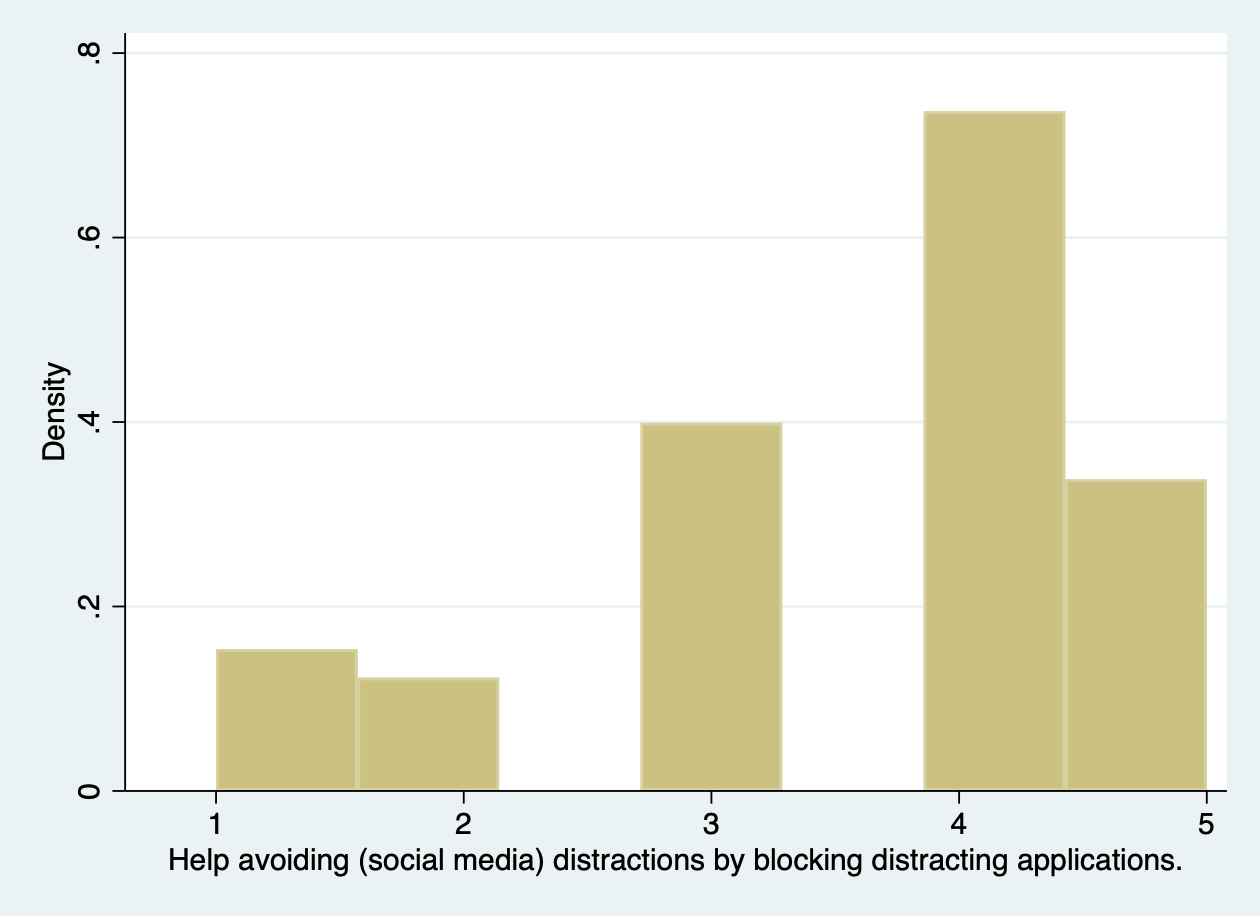
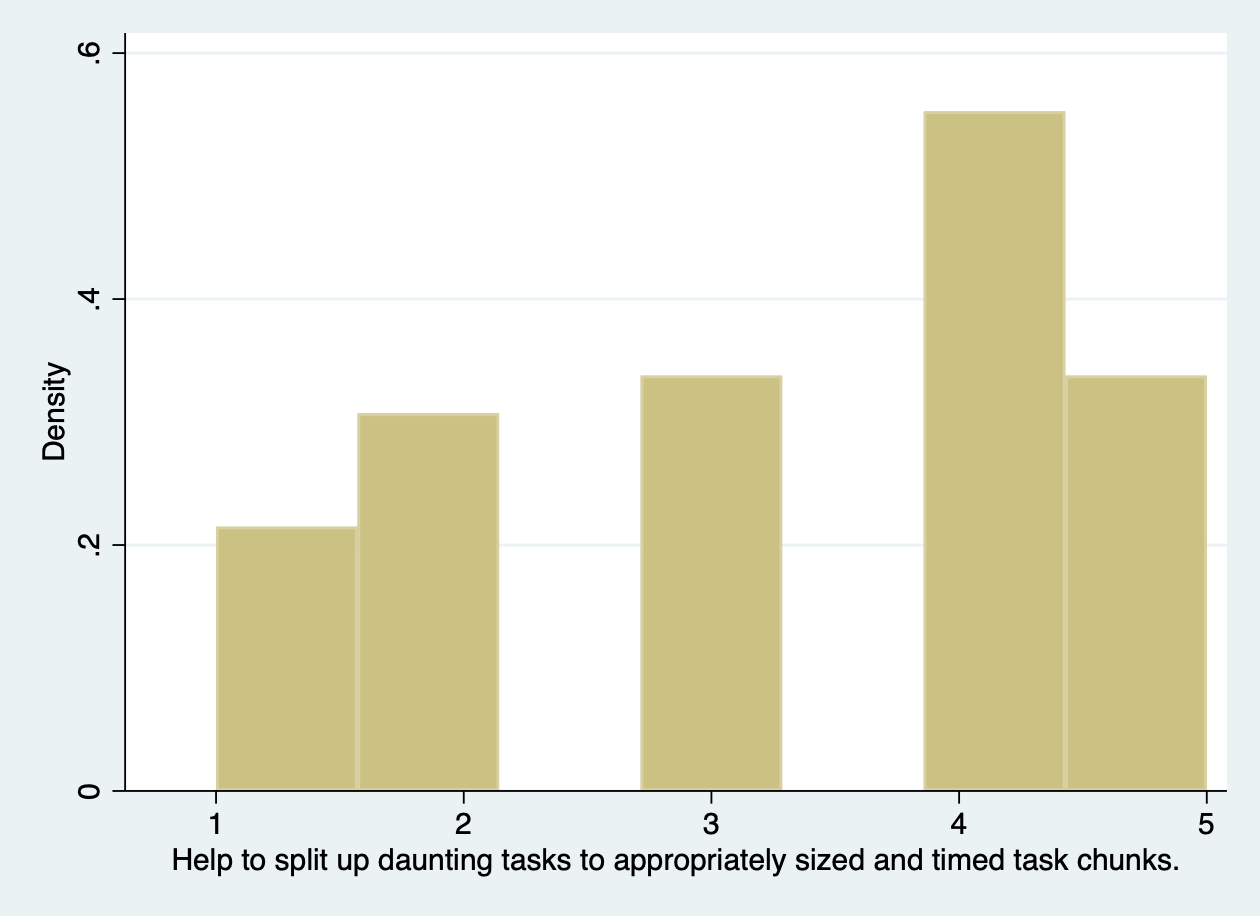
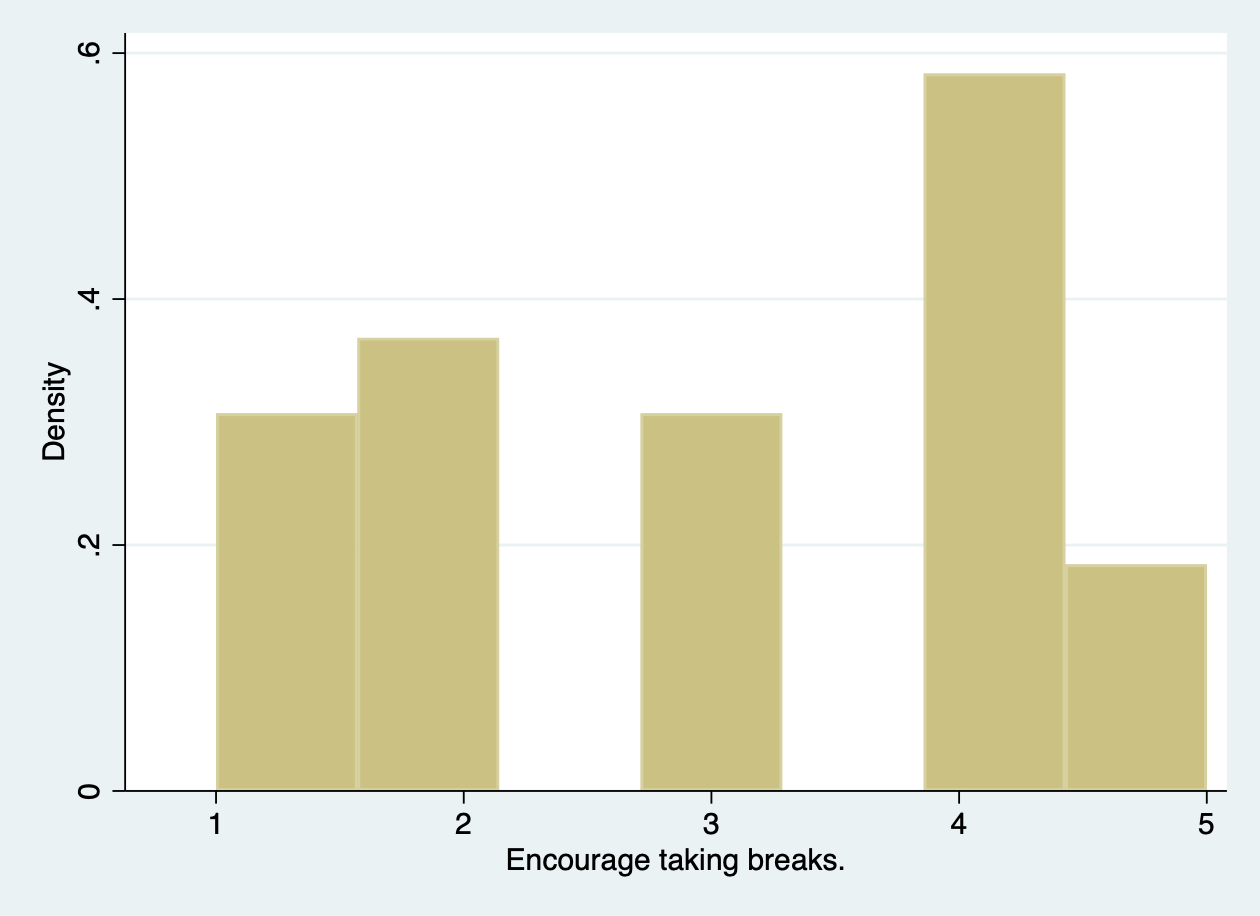
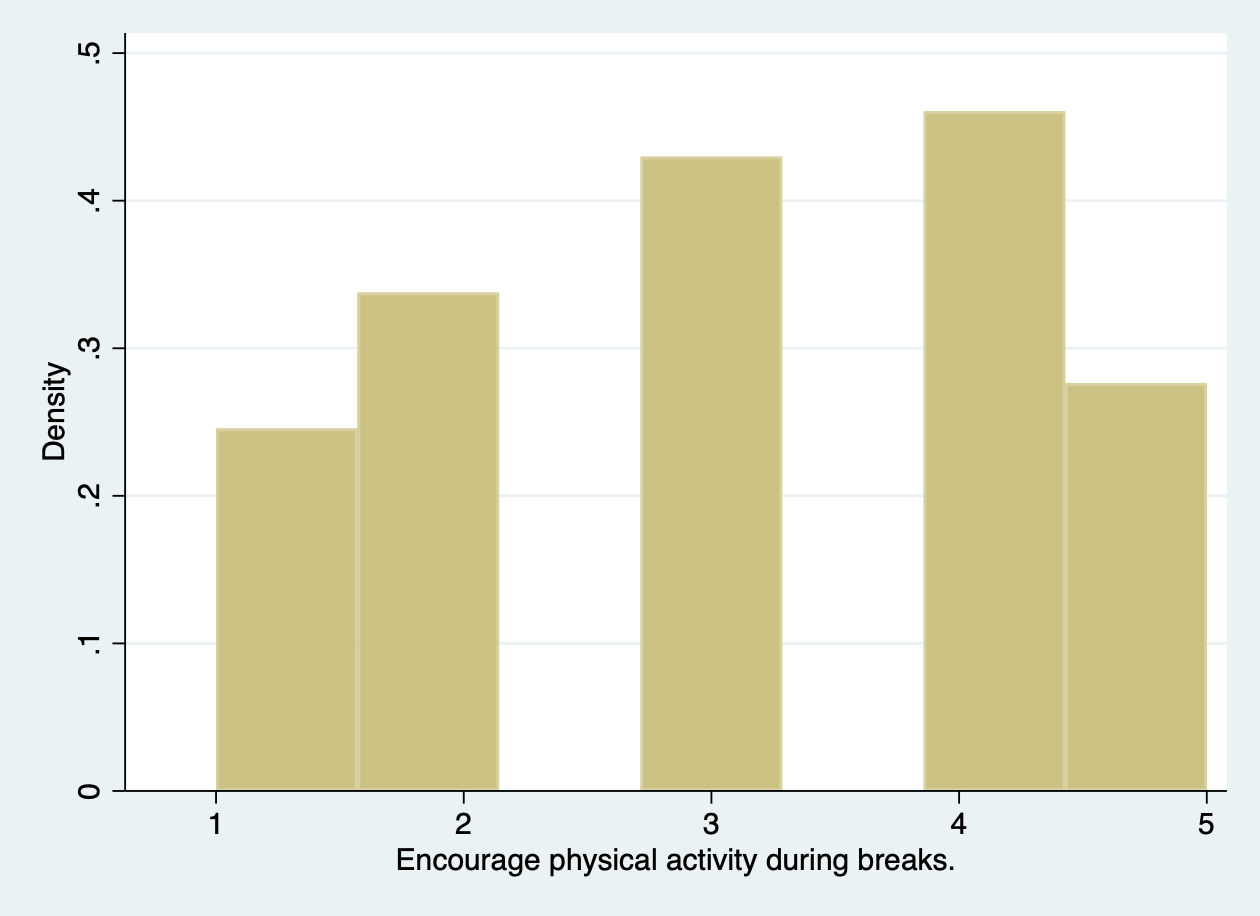
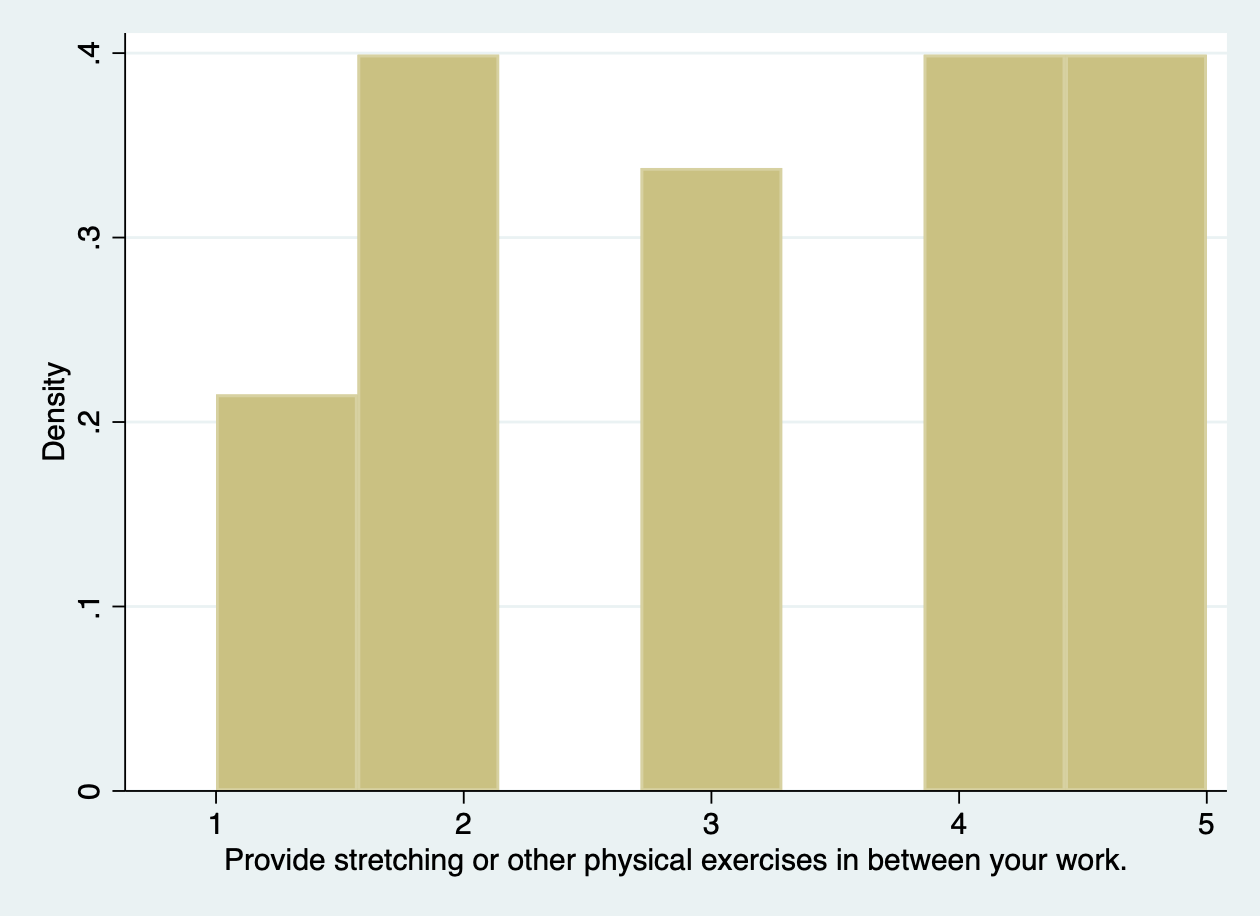
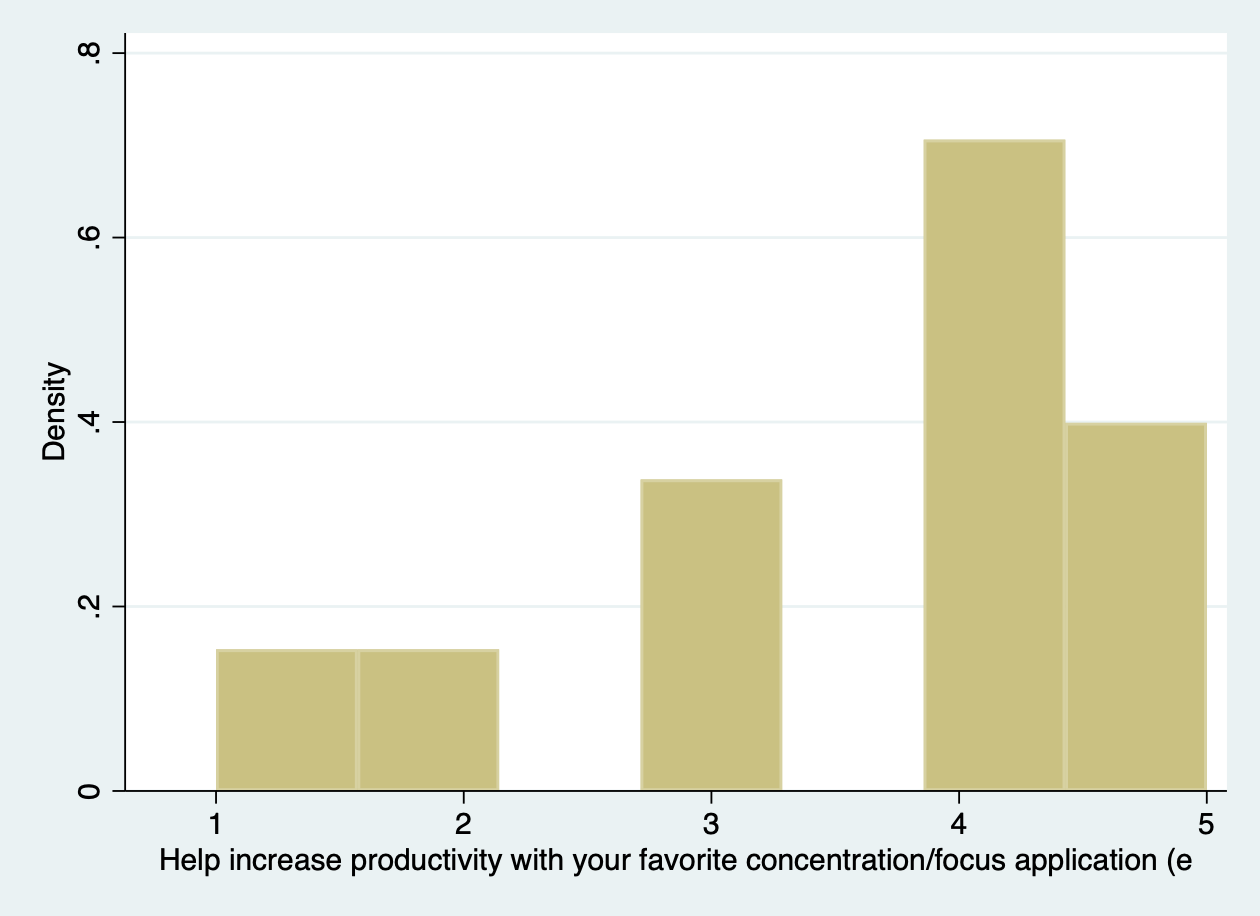
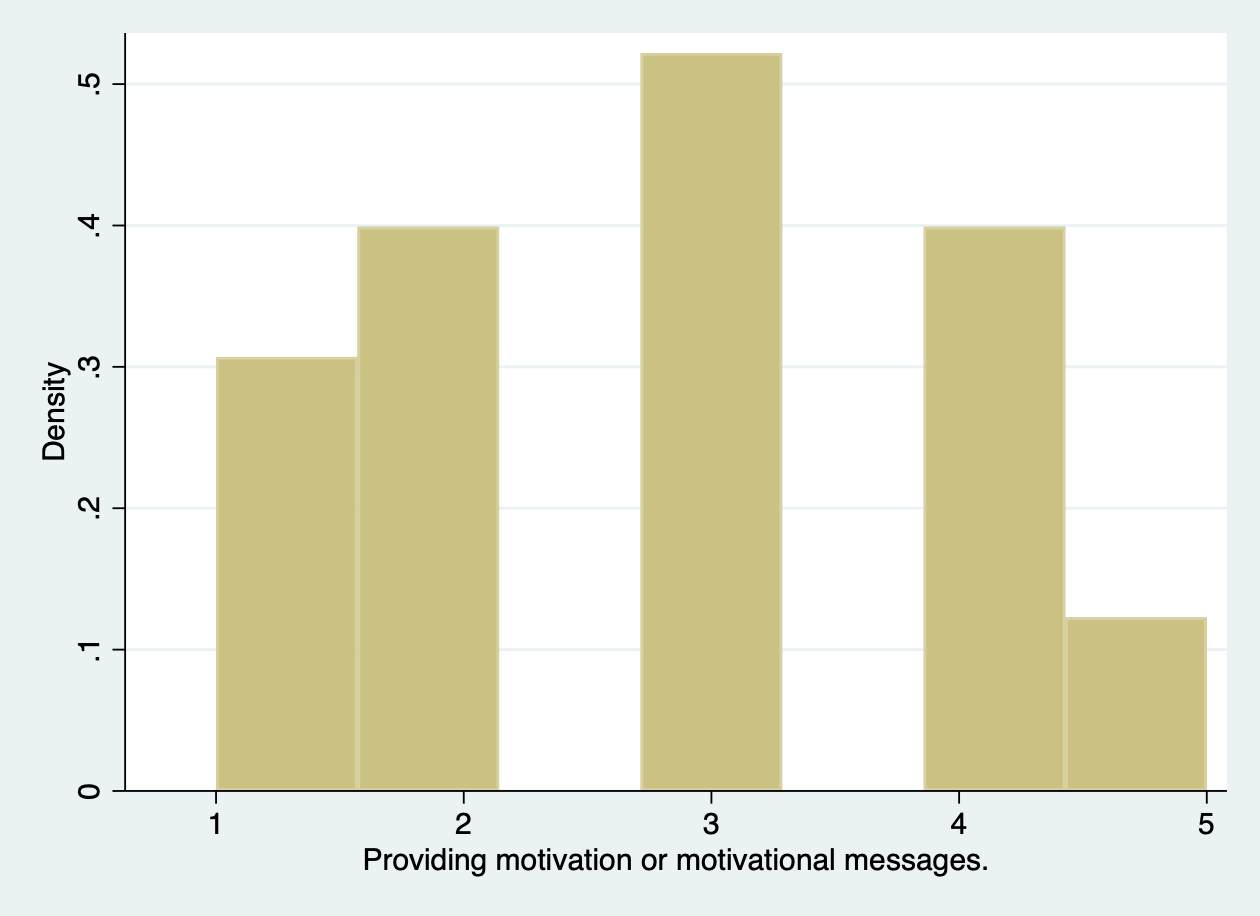
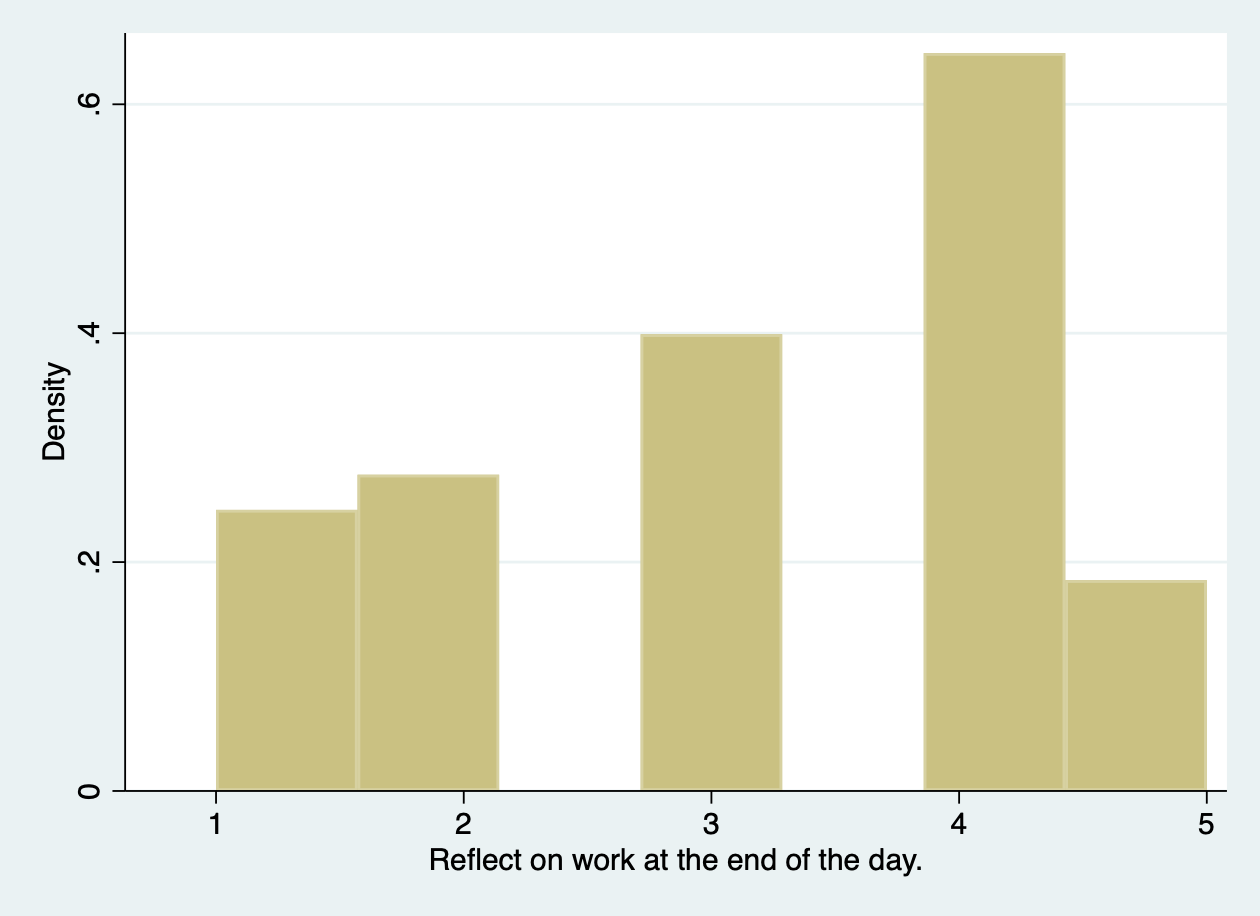
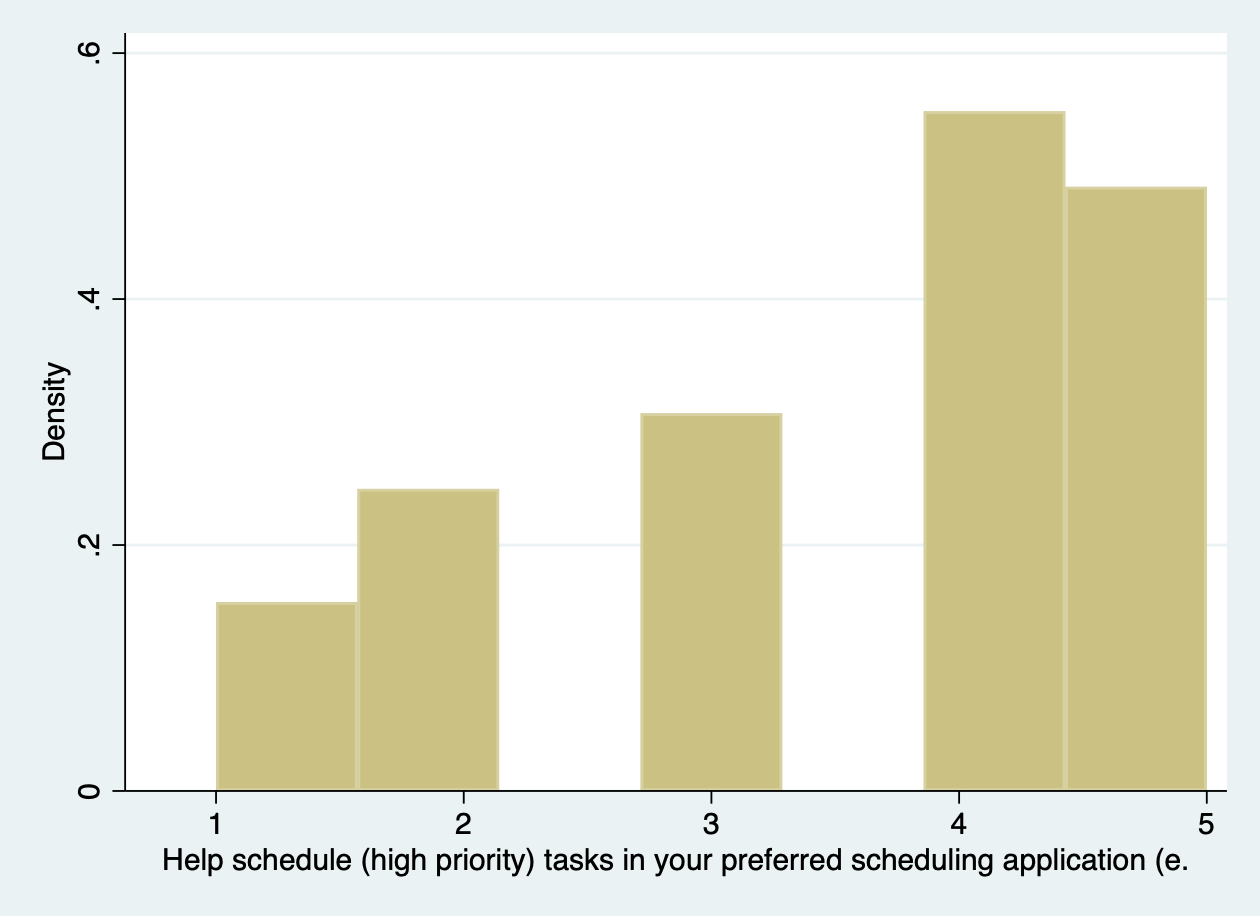
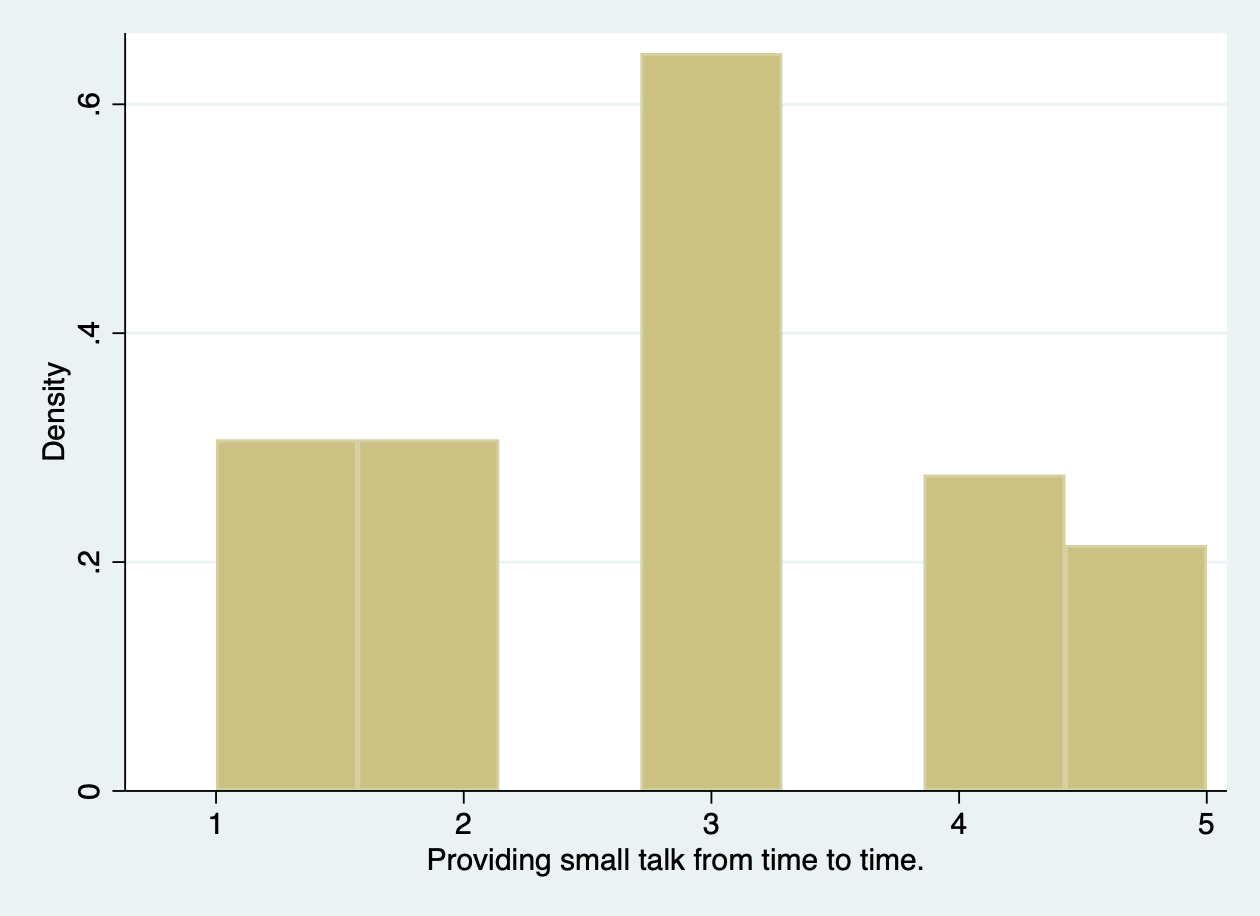
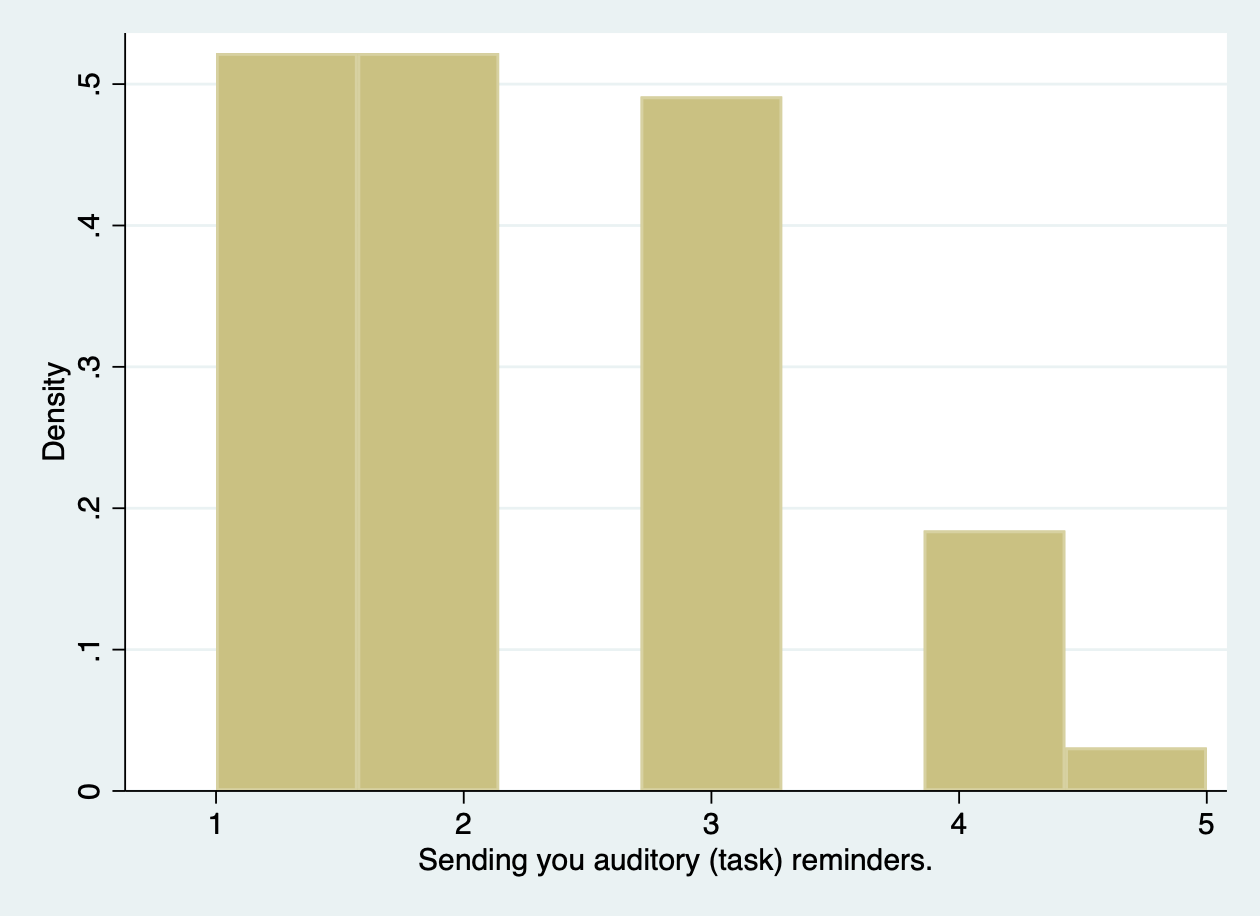

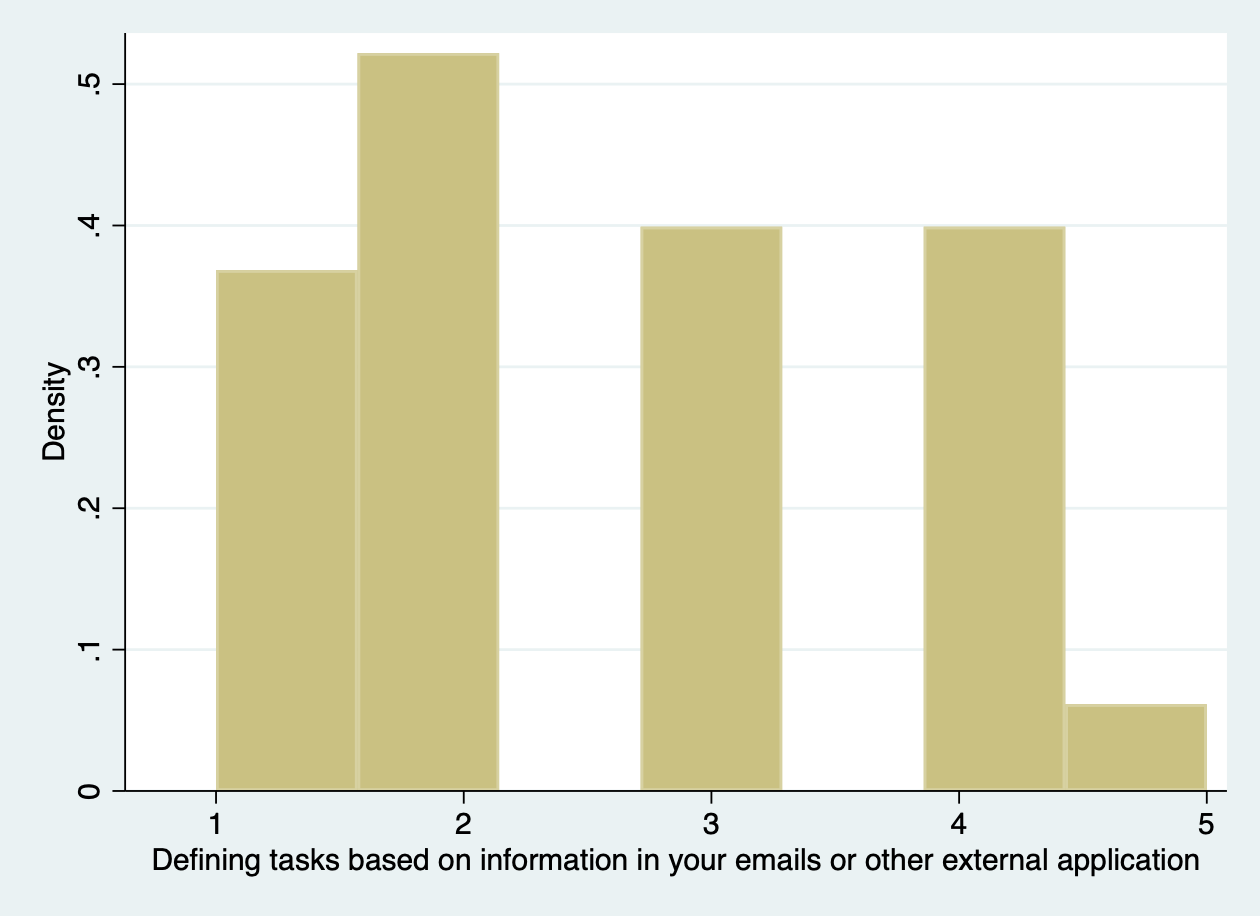
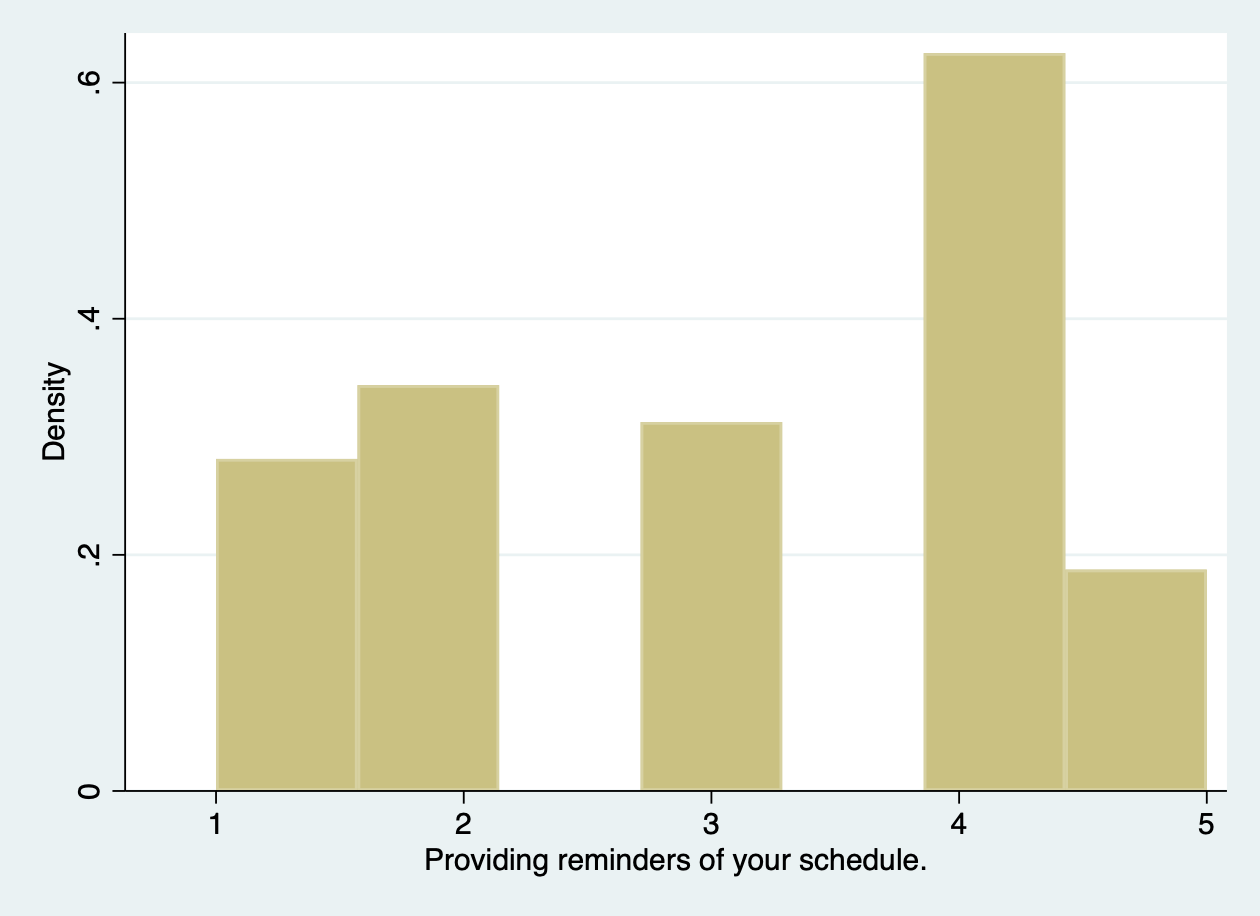
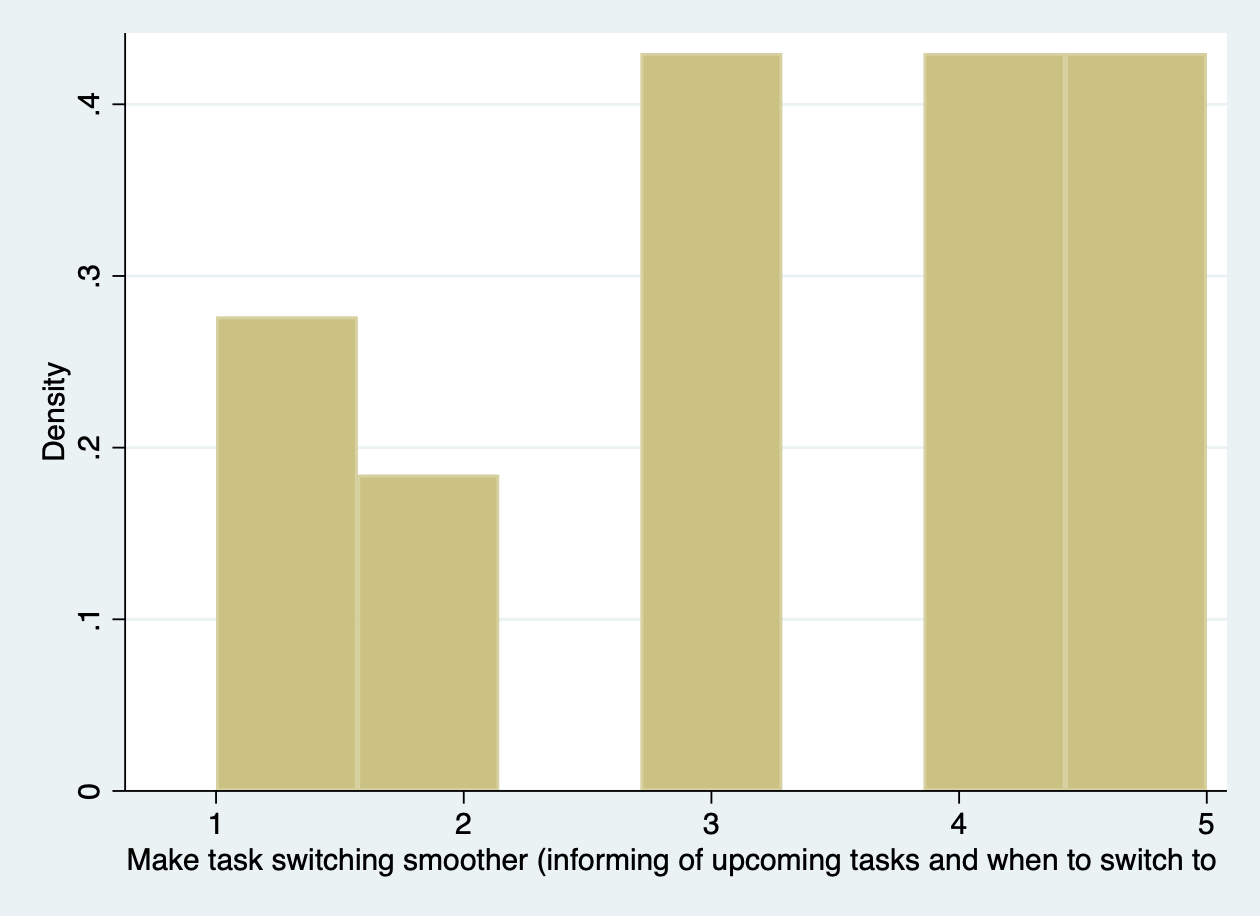
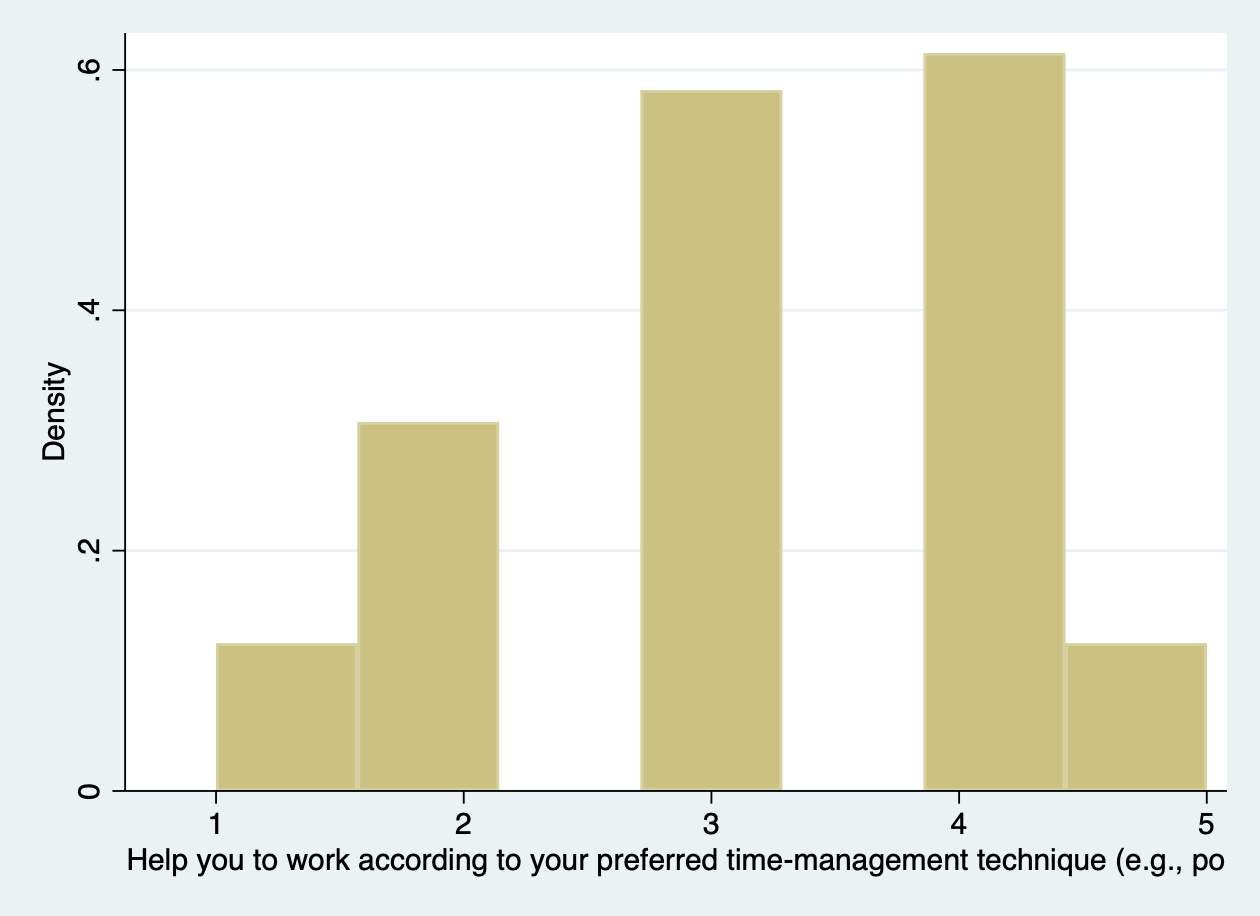
These histograms can be supported by skewness values. A skewness value below zero means that the data is more distributed to the right, while a positive value means that the data is more distributed to the left. We try to find a negative skewness here to confirm what is mentioned above. As can be seen in table 2, all the skewness values of above topics are indeed negative, however, some are larger skewed than others and thus more often chosen to be useful. In conclusion, the most useful tasks (based on negative skewness values between –0.57 to –0.80) are, from highest to lowest; ‘Help avoiding distractions by blocking applications’, ‘Help increase productivity with your favorite concentration/focus application’, ‘Help schedule tasks in your preferred scheduling application’. All other variables have skewness values lower than -0.39 and are thus less helpful than these mentioned above.
Table 2: The skewness values for several variables of what could be helpful tasks of a VA.
| Variables | Skewness |
|---|---|
| Help avoiding distractions by blocking applications | -0.7914 |
| Help to split up daunting tasks | -0.3372 |
| Encourage taking breaks | -0.1631 |
| Encourage physical activity during breaks | -0.1469 |
| Help increase productivity with your favorite concentration/focus application | -0.7717 |
| Reflect on work at the end of the day | -0.3852 |
| Help schedule tasks in your preferred scheduling application | -0.5737 |
| Help you to focus on a currently scheduled task by getting you back from distractions | -0.2038 |
| Providing reminders of your schedule | -0.2560 |
| Make task switching smoother | -0.3755 |
| Help you to work according to your preferred time-scheduling technique | -0.3555 |
To check whether it was a good decision to focus on respondents under 25 years, we have made bar charts of the three most important variables ,grouped by age. The results can be found below and it can be seen that this is indeed a good choice. More younger people have interest in the three most helpful tasks and older people are doubtful or even sure that it will not be helpful.
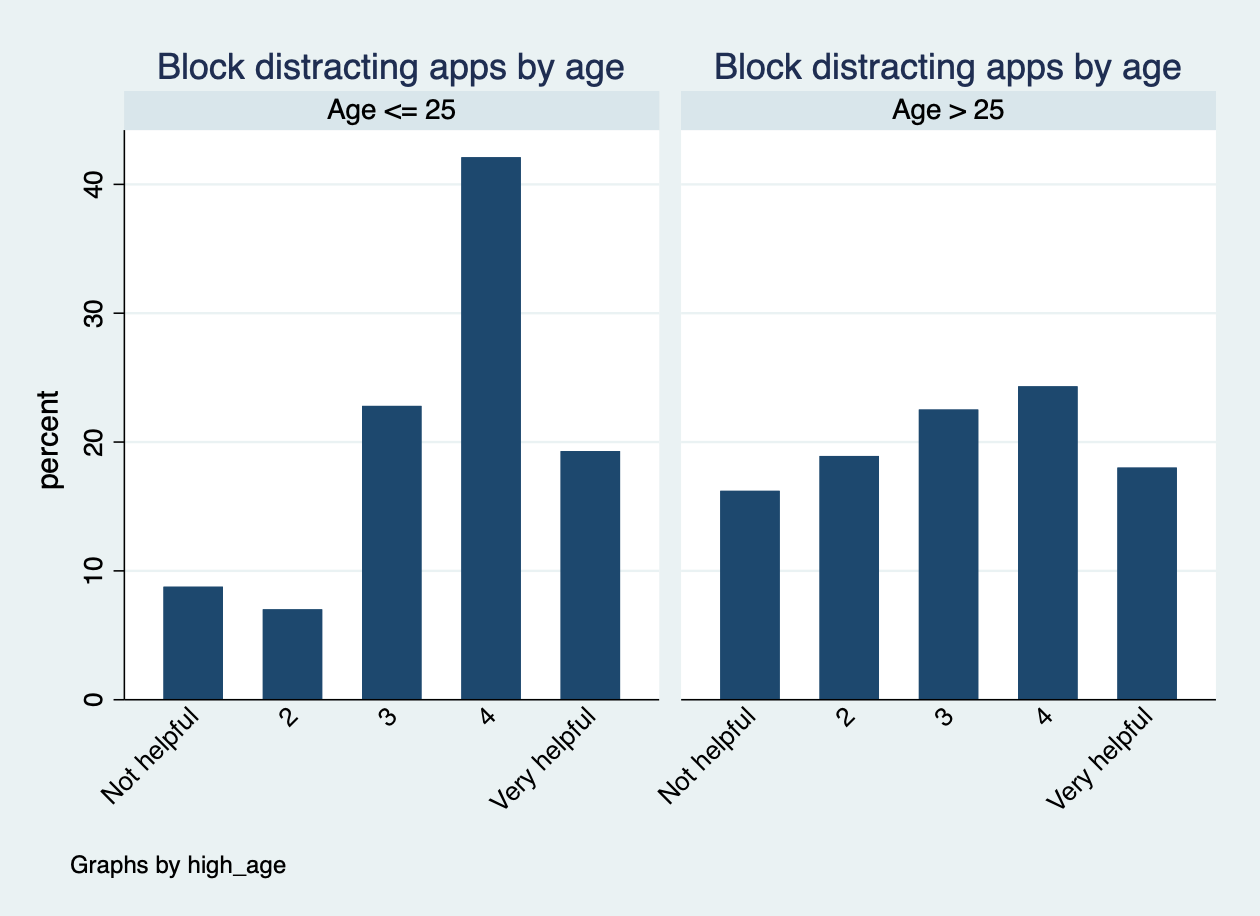
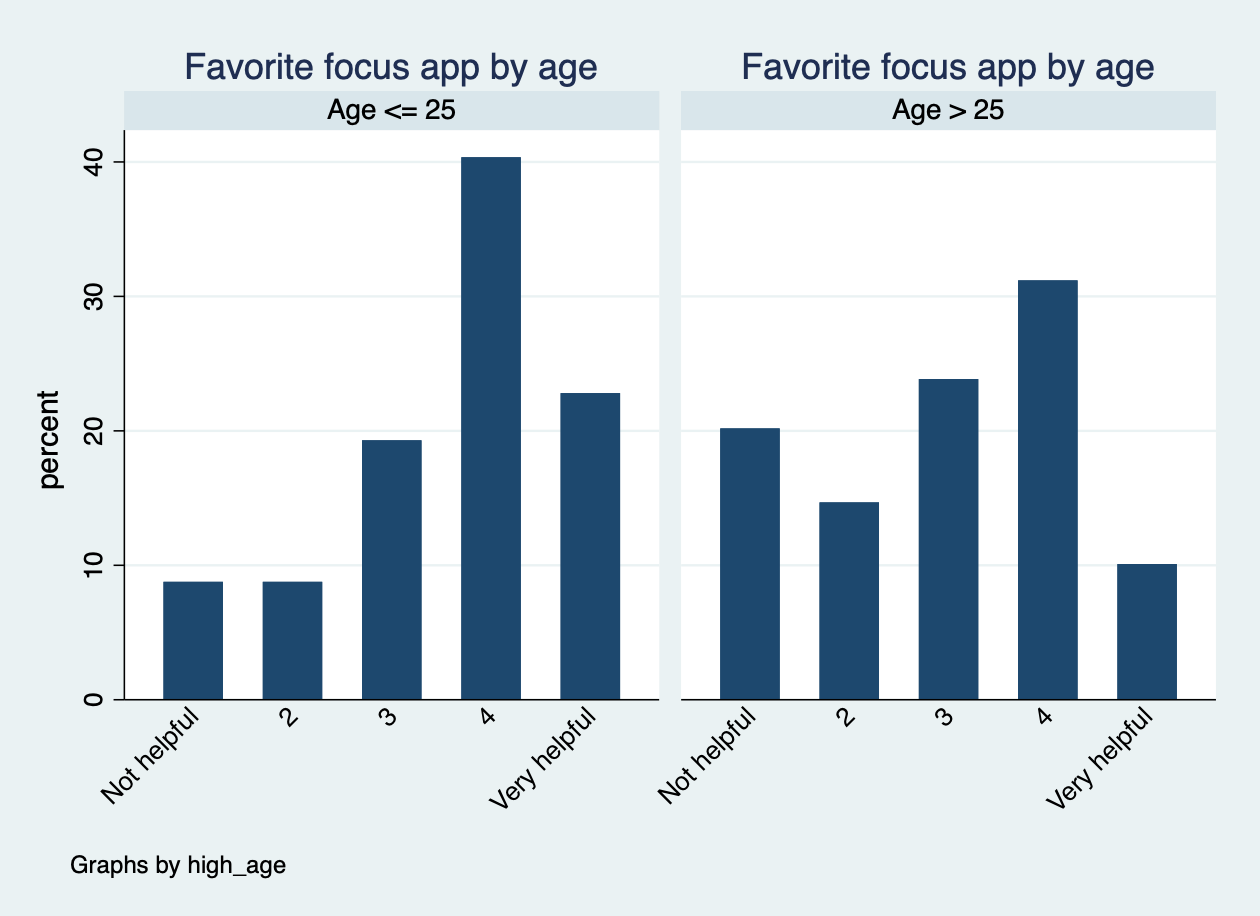
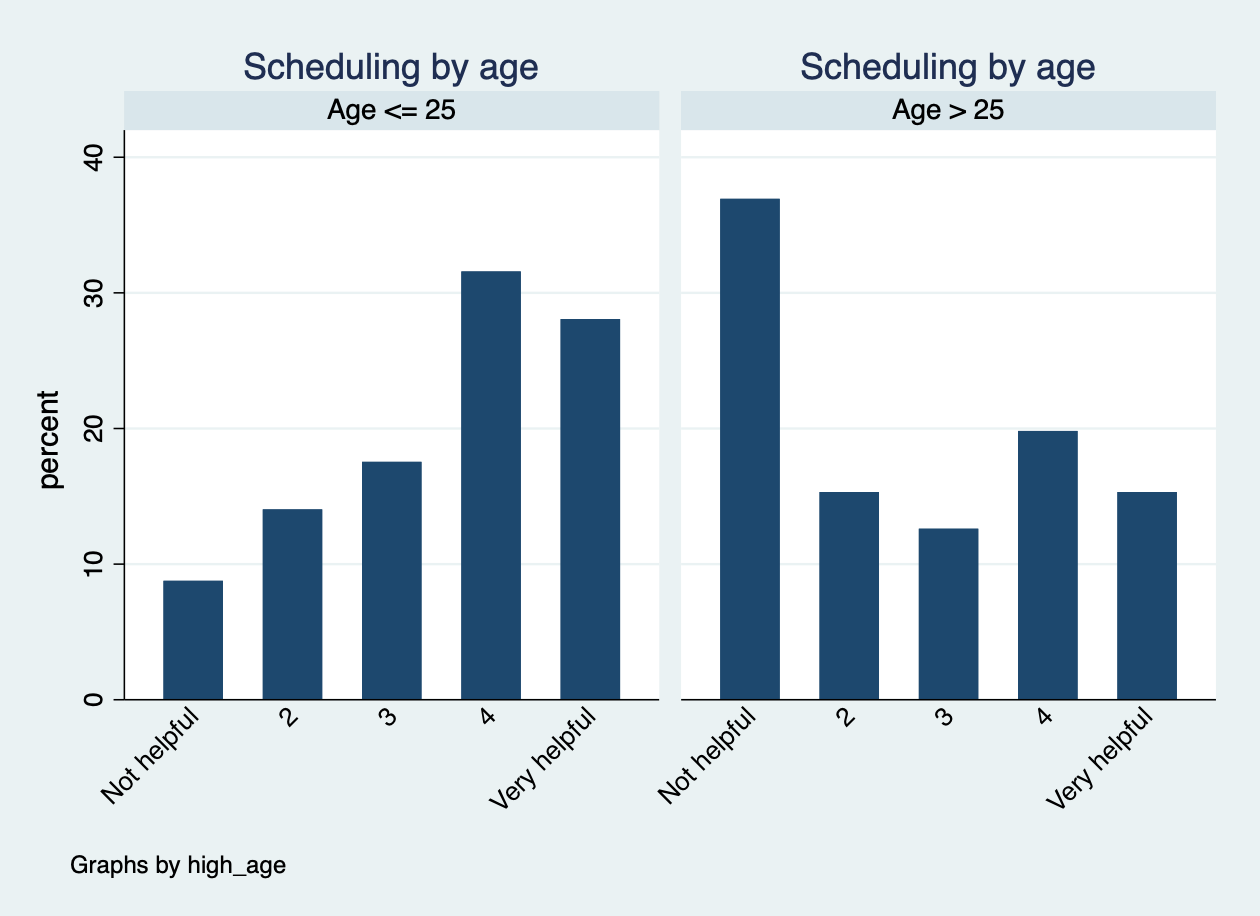
Furthermore, it can be checked using t-tests (or if not allowed; rank sum tests) whether there is a significant difference between age groups for the variables. We start with performing Shapiro-Wilk and Skewness/Kurtosis tests to see if the data is normally distributed. Both p-values should be larger than 0.05 here to not reject the null hypothesis (‘The data is normally distributed’). If this is the case, we may perform a t-test and otherwise we may only perform a non-parametrical test. We will only look for a significant difference in the three most helpful tasks, according to above. Table 3 shows that all variables have a corresponding p-value smaller than 0.05 and thus there is a significance difference between the two age groups and those helpful tasks.
Table 3: The corresponding significance values for the three main helpful tasks variables.
| Variables | Significance value |
|---|---|
| Help avoiding distractions by blocking applications | 0.0287 |
| Help increase productivity with your favorite concentration/focus application | 0.0023 |
| Help schedule tasks in your preferred scheduling application | 0.0001 |
Regarding the open question 'Are there any tasks which aren't mentioned in the list above that you would like a virtual agent to be able to do?', around 20 people have given useful suggestions for extra features of Coco or have confirmed that already existing features will be helpful. Quite a lot of people mentioned that Coco should be connected to streaming services for music or meditations. Furthermore, some people mentioned that they would like it if Coco were connected to their coffee machine or alarm.
It is also mentioned a lot that Coco should suggest a planning for the day based on tasks and order their email on priority. Moreover, it has also been mentioned a few times that Coco should be able to block certain applications and signal to colleagues whether they are busy or not, some people add that this should happen automatically. These are ideas we already had, and it is thus great to hear that the respondents think the same.
In the survey's additional comments, two people gave additional suggestions for functionality. The first mentioned that it would be useful if you can decide to turn of Coco for a while, especially during the weekend this might be useful. Another person worried that Coco should not make them lose their concentration: “The last thing I want is another application that sends me unsolicited and annoying notifications.”
In conclusion, our research question Which tasks are most important for a computer companion to possess? will be answered with the three best options. Coco should be able to help avoid distractions by blocking applications, help increase productivity with users' favorite concentration/focus application, and finally help schedule tasks in users' preferred scheduling application.
Appearance
In the survey, participants had to indicate their preferences for the appearance of Coco. There were three options (human, robot, animal) which they could rank from 1 (most favorable) to 3 (least favorable). The frequency of option 1, 2, or 3 was then encoded for each appearance into three variables (“human_appearance", “robot_appearance", and “animal_appearance"). These results are shown in table 4.
Table 4: Percentages of ranking human, robot, and animal appearance.
| Human | Robot | Animal | |
|---|---|---|---|
| Ranking 1 | 35.71% | 34.52% | 23.21% |
| Ranking 2 | 27.98% | 27.38% | 32.74% |
| Ranking 3 | 29.17% | 29.17% | 34.52% |
As becomes clear from table 4, people like a human or a robot almost exactly the same. An animal, on the other hand, is somewhat less favorable, as it is chosen less often as first option and more often as second or third option. It would be useful to focus more on the preferences between humans and robots in the second survey.
To check for any different preferences between younger (< 25 years) and older (>= 25 years) participants, the histograms shown in Figure X, Figure X, and Figure X are analyzed. Looking at these plots, some differences seem to exist. To check whether these differences are significant, a Chi-square test has been performed for each variable “human_appearance", “robot_appearance", and “animal_appearance". The alpha-value has been set at its default-value of 0.05 and the p-values are 0.000 (human), 0.096 (robot), and 0.012 (animal). Hence, indeed a significant difference is found in the preferences for a human or animal appearance between younger and older people. Older people think a human appearance is most favorable, while younger people think the opposite. Also, older people prefer an animal appearance less than younger people. However, the differences in case of a robot appear to be insignificant.



Regarding the open question 'Would you rather have a different look for your computer buddy than indicated above?', most people did not have any additional comments about the appearance of Coco, however, some trends could be seen amongst the ones that did gave some input. First of all, five people mentioned that they would like the option to customize the appearance of Coco. They mention, for instance, that they would like to choose a figure on one day, and another one on the next day. One person even mentioned the difference between work and leisure. Next to this, they would like the option to adapt the figures themselves. Of course, this would require more (difficult) options in the software. Furthermore, six people mentioned that Coco did not even need an appearance. Something more simplistic, for example such as Siri (mentioned by a couple), would be sufficient in their opinion. Also, eighteen people gave additional options that could be designed. These ranged from “more natural elements” and “a Disney character” to “a self-chosen picture”. Lastly, two persons suggested to change our proposed appearances. One mentioned to make them “somewhat older", while the other would like to see some more details.
Distractions that negatively impact productivity
This section will try to answer the following research questions. The first question is, is there a significant difference in the extent to which the two groups (workers, age > 25 and students age <= 25) experience the negative impact on their productivity? If there is indeed a large difference between the two groups, it might be important to narrow down our user group. And the second research question is what types of distractions have the most influence on productivity? This question is asked so we can prioritize the functions that Coco needs to have.
In the survey, we asked our responders the following; "How often do you get distracted from your work by the following activities?". These activities are the internet, lectures, news, personal mail, scheduled meetings, online shopping, social media, unplanned meetings and work mail. To see what types of distractors have the most influence on productivity, we calculated the mean response for both students and workers. The mean response was based on the different answers the respondents could give to the question, to which they could answer the following: never, less than once a month, a few times a month, a few times a week, daily, 2 or 3 times a day, more than three times a day, in which 1 means never and 7 means more than three times a day. The mean amount of distraction can be seen for both age groups per distraction factor in the table .... below. The significance values are also shown in the table because the effect of the type of distractor can differ significantly per age group. This statistically significant difference is computed with the Wilcoxon rank-sum test.
Table ...: Distraction factors
| Distraction factor | Mean for age <= 25 | Mean for age > 25 | Significance value |
|---|---|---|---|
| Internet | 4.97 | 3.22 | p = 0.0000 |
| Lecture | 3.6 | 1.92 | p = 0.0000 |
| News | 3.71 | 3.08 | p = 0.1617 |
| Personal mail | 3.86 | 3.36 | p = 0.6041 |
| Scheduled meetings | 3.6 | 3.46 | p = 0.2918 |
| Shopping | 3.03 | 1.82 | p = 0.0000 |
| Social media | 5.4 | 2.9 | p = 0.0000 |
| Unplanned meetings | 2.8 | 3.58 | p = 0.0002 |
| Work mail | 4.06 | 4.64 | p = 0.0005 |
As you can see in table ....., the mean distraction is higher for every sort of distraction type except for work-related mail. This highlights that students’ (people aged <= 25) productivity is more often affected by these distractions than the productivity of working people. To give an example, a mean of 4.97 (internet) for people aged 25 or lower means that they are distracted 'daily' on average. The differences between the two groups are significant for internet, lectures, shopping, social media, unplanned meetings and for work mail. This table also informs us about what types of distractors have the most influence on both groups. For clarity, table ..... below shows the rank order of the amount of distraction per age group.
| Rank | Students | Workers |
|---|---|---|
| 1. | Social media | Work mail |
| 2. | Internet | Unplanned meetings |
| 3. | Work mail | Scheduled meetings |
| 4. | Personal mail | Personal meetings |
| 5. | News | Internet |
| 6. | Lectures & Scheduled meetings | News |
| Scheduled meetings | ||
| 7. | Shopping | Social media |
| 8. | Unplanned meetings | Lectures |
| 9. | Shopping |
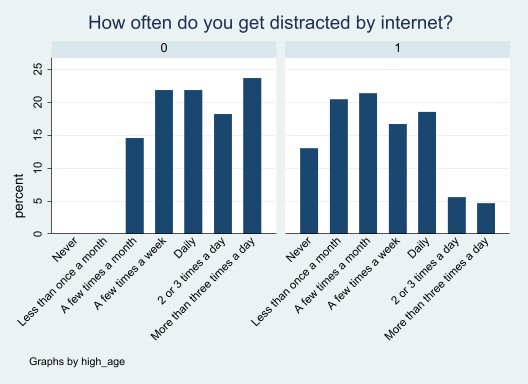
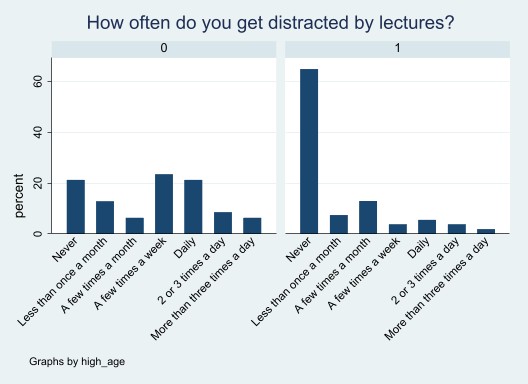

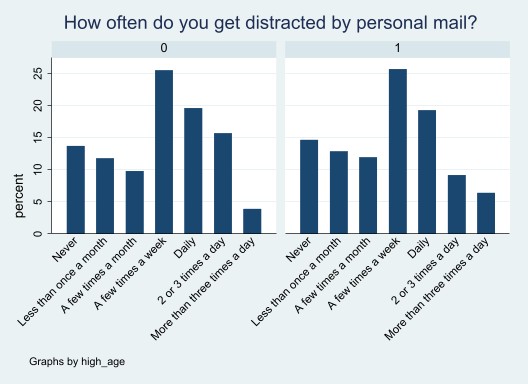
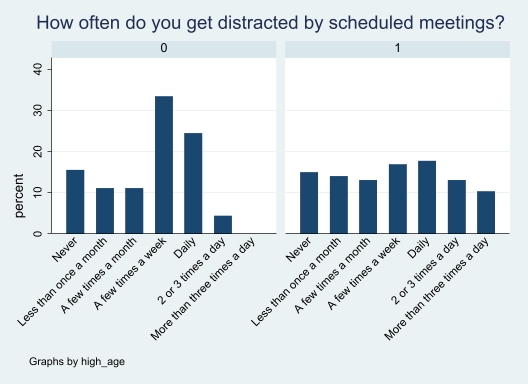


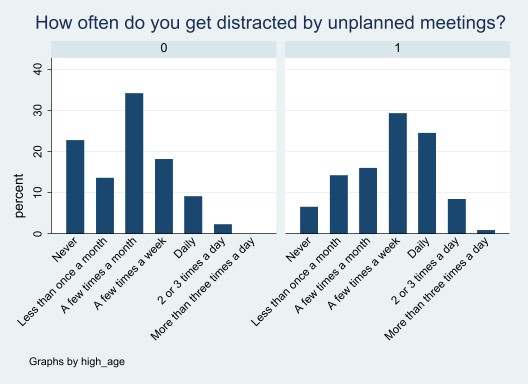
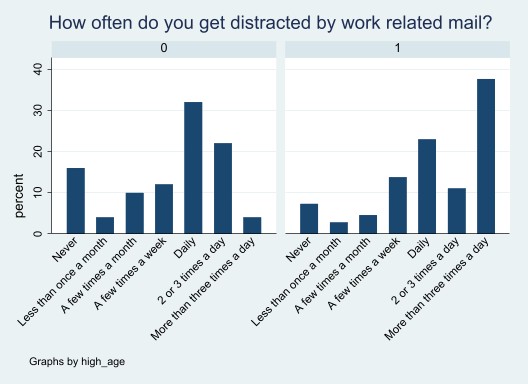
To summarize, there is indeed a significant difference between the two age groups and the times that they get distracted by different factors, so this again confirms that it is a good idea to split up the groups and investigate them separately. From both the graphs and the statistical analysis you can see that students are more often distracted by multiple factors than workers. For these students, the two largest distractor factors are, by far, social media and the internet. These factors distract students two or three times a day and daily (respectively).
Money
There were quite some different answers to the question what people were willing to pay for Coco. There were three main categories in which people answered the question. One was paying per certain period, for example a monthly or yearly fee. The second category of people wanted Coco to be a one-time buy, and the third category consists of other answers.
Payments per period
Around 17 people said that they would like to pay monthly or yearly, however the amount that they were willing to pay varied widely. Most of these people wanted to pay somewhere between 5 – 20 Euros per month.
One-time buy
The amount of money that people were willing to pay in a one-time buy varied widely again, between 2 Euros to 500 Euro's. However, most people responded with 10 Euro's and 50 Euro's. The average price that people were willing to pay was approximately 68 Euro's.
Other
17 people mentioned that they did not want to pay for the software and there were also some additional ideas posed by the respondents, for example, 9 people mentioned that 'work should pay for this'. Besides that, some people said that they wanted a free tryout first to see the functionalities before they want to pay for it. If results are good, they are willing to pay around 10 Euros per month or around 100 Euros per year. Moreover, a few people commented that it depends on the type of license; a one-time purchase, or pay on monthly base or yearly base? This was an unnecessary dubiety on our side.
General conclusion of analysis 1
As indicated in the second part of the analysis 'Corona impact on productivity and health', it might be best to focus on people of 25 years old or younger. Their productivity, concentration, mental health, and physical health have decreased the most since COVID-19. Coco would be best of help for the users if it could aid them during their work considering these aspects.
Because almost all the frequencies of the distraction types are higher for students than for workers, it can be concluded that Coco would be more useful for students. The two things that distract students the most compared to the other distraction factors are social media, and the internet. Therefore it is of great importance that Coco will be able to prevent the students from getting distracted by at least these two factors.
References
- ↑ 1.0 1.1 1.2 1.3 1.4 1.5 Xiao, Y., Becerik-Gerber, B., Lucas, G., & Roll, S. C. (2021). Impacts of Working From Home During COVID-19 Pandemic on Physical and Mental Well-Being of Office Workstation Users. Journal of Occupational and Environmental Medicine, 63(3), 181–190. https://doi.org/10.1097/JOM.0000000000002097 Cite error: Invalid
<ref>tag; name "Xiao" defined multiple times with different content - ↑ 2.0 2.1 2.2 Werneck, A. O., Silva, D. R., Malta, D. C., Souza-Júnior, P. R. B., Azevedo, L. O., Barros, M. B. A., & Szwarcwald, C. L. (2021). Changes in the clustering of unhealthy movement behaviors during the COVID-19 quarantine and the association with mental health indicators among Brazilian adults. Translational Behavioral Medicine, 11(2), 323–331. https://doi.org/10.1093/tbm/ibaa095 Cite error: Invalid
<ref>tag; name "Werneck" defined multiple times with different content - ↑ Siqueira, L. T. D., Santos, A. P. dos, Silva, R. L. F., Moreira, P. A. M., Vitor, J. da S., & Ribeiro, V. V. (2020). Vocal Self-Perception of Home Office Workers During the COVID-19 Pandemic. Journal of Voice. https://doi.org/10.1016/j.jvoice.2020.10.016
- ↑ 4.0 4.1 Niemi, H. M., & Kousa, P. (2020). A Case Study of Students’ and Teachers’ Perceptions in a Finnish High School during the COVID Pandemic. International Journal of Technology in Education and Science, 4(4), 352–369. https://doi.org/10.46328/ijtes.v4i4.167
- ↑ 5.0 5.1 Ta, V., Griffith, C., Boatfield, C., Wang, X., Civitello, M., Bader, H., DeCero, E., & Loggarakis, A. (2020). User experiences of social support from companion chatbots in everyday contexts: Thematic analysis. Journal of Medical Internet Research, 22(3). https://doi.org/10.2196/16235
- ↑ Odekerken-Schröder, G., Mele, C., Russo-Spena, T., Mahr, D., & Ruggiero, A. (2020). Mitigating loneliness with companion robots in the COVID-19 pandemic and beyond: an integrative framework and research agenda. Journal of Service Management, 31(6), 1149–1162. https://doi.org/10.1108/JOSM-05-2020-0148
- ↑ Cambo, S. A., Avrahami, D., & Lee, M. L. (2017). BreakSense: Combining physiological and location sensing to promote mobility during work-breaks. Conference on Human Factors in Computing Systems - Proceedings, 2017-May, 3595–3607. https://doi.org/10.1145/3025453.3026021
- ↑ Henning, R. A., Jacques, P., Kissel, G. V., Sullivan, A. B., & Alteras-Webb, S. M. (1997). Frequent short rest breaks from computer work: Effects on productivity and well-being at two field sites. Ergonomics, 40(1), 78–91. https://doi.org/10.1080/001401397188396
- ↑ Abbasi, S., & Kazi, H. (2014). Measuring effectiveness of learning chatbot systems on Student’s learning outcome and memory retention. In Asian Journal of Applied Science and Engineering (Vol. 3).
- ↑ Henning, R. A., Jacques, P., Kissel, G. V., Sullivan, A. B., & Alteras-Webb, S. M. (1997). Frequent short rest breaks from computer work: Effects on productivity and well-being at two field sites. Ergonomics, 40(1), 78–91. https://doi.org/10.1080/001401397188396
- ↑ Lester, J. C., Barlow, S. T., Converse, S. A., Stone, B. A., Kahler, S. E., & Bhogal, R. S. (1997). Persona effect: Affective impact of animated pedagogical agents. Conference on Human Factors in Computing Systems - Proceedings, 359–366.
- ↑ 12.0 12.1 12.2 Grover, T., Rowan, K., Suh, J., McDuff, D., & Czerwinski, M. (2020). Design and evaluation of intelligent agent prototypes for assistance with focus and productivity at work. International Conference on Intelligent User Interfaces, Proceedings IUI, 20, 390–400. https://doi.org/10.1145/3377325.3377507
- ↑ Kimani, E., Rowan, K., McDuff, D., Czerwinski, M., & Mark, G. (2019). A Conversational Agent in Support of Productivity and Wellbeing at Work. 2019 8th International Conference on Affective Computing and Intelligent Interaction, ACII 2019, 332–338. https://doi.org/10.1109/ACII.2019.8925488
- ↑ Klein, J., Moon, Y., & Pieard, R. W. (1999). This computer responds to user frustration. Conference on Human Factors in Computing Systems - Proceedings, 242–243. https://doi.org/10.1145/632716.632866
- ↑ Cambo, S. A., Avrahami, D., & Lee, M. L. (2017). BreakSense: Combining physiological and location sensing to promote mobility during work-breaks. Conference on Human Factors in Computing Systems - Proceedings, 2017-May, 3595–3607. https://doi.org/10.1145/3025453.3026021
- ↑ Kessens, J. M., Neerincx, M. A., Looije, R., Kroes, M., & Bloothooft, G. (2009). Facial and vocal emotion expression of a personal computer assistant to engage, educate and motivate children. Proceedings - 2009 3rd International Conference on Affective Computing and Intelligent Interaction and Workshops, ACII 2009. https://doi.org/10.1109/ACII.2009.5349582
- ↑ Searle, J. R. (1980). Minds, Brains and Programs. Behavioral and Brain Sciences, 417-424. https://doi.org/10.1017/S0140525X00005756
- ↑ 18.0 18.1 Fan, L., Scheutz, M., Lohani, M., Mccoy, M., & Stokes, C. (2017). Do We Need Emotionally Intelligent Artificial Agents? First Results of Human Perceptions of Emotional Intelligence in Humans Compared to Robots. Springer International Publishing AG 2017, 129–141. https://doi.org/10.1007/978-3-319-67401-8_15
- ↑ Tanaka, K., Nakanishi, H., & Ishiguro, H. (2014). Comparing video, avatar, and robot mediated communication: Pros and cons of embodiment. Communications in Computer and Information Science, 96–110. https://doi.org/10.1007/978-3-662-44651-5_9
- ↑ Milne, M., Luerssen, M. H., Lewis, T. W., Leibbrandt, R. E., Powers, D. M. W. (2010). Development of a virtual agent based social tutor for children with autism spectrum disorders.Proceedings of the International Joint Conference on Neural Networks, 1–9. https://doi.org/10.1109/IJCNN.2010.5596584
- ↑ Lee, K. M., Jung, Y., Kim, J., & Kim, S. R. (2006). Are physically embodied social agents better than disembodied social agents?: The effects of physical embodiment, tactile interaction, and people's loneliness in human–robot interaction. International Journal of Human Computer Studies, 962-973. https://doi.org/10.1016/j.ijhcs.2006.05.002
- ↑ Wang, B., & Rau, P. L. P. (2019). Influence of Embodiment and Substrate of Social Robots on Users’ Decision-Making and Attitude. International Journal of Social Robotics, 411-421. https://doi.org/10.1007/s12369-018-0510-7
- ↑ Shinozawa, K., Naya, F., Yamato, J., Kogure, K. (2005). Differences in effect of robot and screen agent recommendations on human decision-making. International Journal of Human Computer Studies, 267-279. https://doi.org/10.1007/s12369-018-0510-7
- ↑ Puehn, C. G., Liu, T., Feng, Y., Hornfeck, K., & Lee, K. (2014). Design of a low-cost social robot: Towards personalized human-robot interaction. Lecture Notes in Computer Science, 704-713. https://doi.org/10.1007/978-3-319-07446-7_67
- ↑ Avramova, V., Yang, F., Li, C., Peters, C., & Skantze, G. (2017). A virtual poster presenter using mixed reality. Lecture Notes in Computer Science. https://doi.org/10.1007/978-3-319-67401-8_3
Appendix
Appendix A - Stata do-file analysis survey 1
Here the do-file for the analysis of survey 1 can be found.


